You know everything you need to know to put 3Sig to work in your accounts right now. You might still hesitate, though. It’s nothing like the advice you’ve read and heard elsewhere. You know it’s a simple plan and understand each part of it, but may not be able to picture it in action through the chaos of the market.
To get around this, we’ll watch how an investor uses the plan over a time period fraught with real news, and how the plan compares with more typical long-term investment approaches. We’ll do so by following the lives of three fictional investors at the same company, on the same earnings path, using the same 401(k), and dealing with the same maelstrom of events ripped from the headlines. The only difference among the three is what they do with their same level of savings within the same set of investment options—with wildly different results. Two of the characters are archetypes of the most common investment personalities I’ve encountered: the part-time trader plagued by z-vals and the diligent saver unnerved by volatility. The third runs 3Sig.
I want you to feel clearly the power of 3Sig, to see how it makes investment life easier and more profitable, so we’re going to go into some depth. Sit back with me as we navigate actual news stories and z-val forecasts to understand the impact they have on people trying to plan for the future while living life. Notice how forecasters have always seemed believable, and how they’ve always said many of the same things you hear them saying today. Notice, too, that they’ve been wrong about half the time. File this away in your wisdom vault. Investing wouldn’t be a challenge if the experts looked like buffoons. It’s a challenge because they look like experts and we want to trust them, but they’re wrong as often as amateurs.
This chapter will give you more than a textbook view of 3Sig. It will take you into the real-life experience of running the plan so you know what to expect when implementing it in your own life.
The Setup
Our three investors begin at age thirty as new employees at SnapSheet, an information analytics company based in Denver, Colorado. Each is a data scientist with a different specialty. Their family situations are different, too. Garrett is married without children, Selma is a single mother of two, and Mark is married with three children. Each started his or her career at SnapSheet with an annual salary of $54,000 at the end of 2000. That was $4,500 per month, from which each contributed 6 percent, or $270, to SnapSheet’s 401(k). The company matched 50 percent of contributions up to 6 percent, which is why all three contributed the minimum amount to get the maximum company match, pushing their net monthly contribution up to $405, or $1,215 per quarter. From their retirement accounts at previous employers, each transferred $10,000 into SnapSheet’s 401(k). So their initial investment balances were $10,000, and their starting quarterly contributions were $1,215.
Garrett had always been interested in the stock market. In his twenties, he read trading books, attended a technical analysis seminar, and opened an individual brokerage account where he’d tried his hand at picking a few winners. His results were mixed, but he felt he’d been improving at the time he hired on with SnapSheet and took a look at its 401(k). He was happy to find that it offered a long list of mutual funds and also included a brokerage option where he could buy and sell anything he wanted. He was eager to do so, especially since he believed cheaper prices after the dot-com crash provided potential to get ahead in a recovery.
Selma’s main concern was taking care of her two children on a single salary. The last thing she wanted to worry about was the whim of Wall Street, so she’d read financial planning books and taken a community college class on asset allocation for the long haul. She was happy to find a suitable collection of mainstream mutual funds in the SnapSheet 401(k). With them, she would create a retirement mix that benefited from the long-term growth of the stock market with some safety added by putting some of her account in steadier funds. She got to work choosing the right mix.
Mark was a dedicated family man, leaving work at work and spending as much time as possible with his wife and three kids. He shared Selma’s desire to keep the whim of Wall Street out of his life, but he knew he needed the growth potential of stocks in his retirement account. He researched asset allocation as a way to balance growth with safety. The problem he noticed was that doing so didn’t produce as much profit as he was hoping to amass. He studied stock index funds as a low-cost way to get more performance with more risk that paid off in eventual recoveries from setbacks, and then stumbled onto 3Sig. He liked it best of all because it would focus his capital not just on stocks, but on the highest potential small-cap segment of stocks, supported by the bond account for stability and quarterly trades based on the signal. It would also provide him with buying power in a downturn, something his past experience with dollar-cost averaging never had. The 3Sig technique seemed like the best way to get high profits with little stress out of low-cost index funds, so Mark decided to adopt the plan.
When these three began work at SnapSheet in early December 2000, the Nasdaq had fallen 45 percent since peaking on March 10. The presidential election had been a fiasco, and when the three arrived at SnapSheet, the country still didn’t know whether George W. Bush or Al Gore had won. On December 12, the Supreme Court would decide that Bush was president, but after that it would be discovered that Gore had actually won the popular vote. The crashing Nasdaq and contentious election made it a tough time to decide where to invest a 401(k).
Garrett thought the deflated Internet stock universe, which was taking a pounding almost daily in the media, offered a lot of latent value. He looked back at the darlings of the bubble—JDS Uniphase, Nortel, Sycamore, and others—and thought he finally had a chance to buy on the cheap all the stocks those bragging blowhards at his former company had teased him about for not owning in the final three years of the 1990s. What he called bragging blowhards you and I know as Peter Perfect. Garrett was vulnerable to their taunting.
He figured it would be hard to pick through the rubble of the Internet wasteland, but worth it, and he knew just the man for the job: Ryan Jacob, of Jacob Internet Fund fame. Sure, Jacob was being keelhauled by every reporter as the best fish-in-a-barrel proxy for what went wrong with net stocks, but Garrett had a feeling Jacob would be the star of “Comeback Kid” cover stories within a few years. About the time the latecomers piled in for the next phase of online stock growth after such stories, Garrett figured he’d be up 100, maybe 300 percent. That’s what happened in the good old days of just a year or two earlier, and so he thought it would happen again, and with a vengeance now that Jacob’s Internet Fund was beaten flat on its back.
Landon Thomas Jr. wrote in the New York Observer in October that Ryan Jacob used to be famous as an Internet investing rock star after turning $200,000 into $25 million in 1998, taking the top performance spot among mutual funds that year. Currently, however, his fund ranked dead last after losing 54.1 percent year-to-date. “Yet Mr. Jacob remains nothing if not steadfast,” Thomas wrote, citing Jacob’s praise of his third-largest holding, a company called iVillage, which topped out at $100 per share in April 1999 but was now $3. Jacob told Thomas, “The stock has underperformed, not the company.”
Garrett decided it was time to really go for it, and so he put half his $10,000 into Jacob Internet Fund for the recovery. The other half he decided to put into more traditional stock funds, just in case the Internet didn’t have as much recovery potential as he suspected.
He chose Wasatch Small-Cap Growth after it topped a list of “Small-Cap Growth Funds with Long-Tenured Managers” at TheStreet.com, which said the fund “has a record that’s tough to ignore. Jeff Cardon has held the reins since the fund’s 1986 inception and his track record is solid. Thanks to his measured approach, the fund beats 75 percent of its peers over the last one-, three-, five- and 10-year periods, according to Morningstar.”
Garrett selected Janus Global Technology for a wider perspective on tech potential than Ryan Jacob specialized in. He read the following in “Mike Molinski’s FundWatch” at MarketWatch in October:
A recent study by fund-tracking firm Wiesenberger found that global technology funds actually have a lower standard deviation than domestic technology funds, 47.65 versus 61.62, meaning that day-to-day, their closing prices don’t stray as much from their average price. . . .
What’s more, adding a global technology fund to an all-domestic portfolio can reduce the overall risk level of your investment portfolio because foreign stocks don’t move in tandem with U.S. stocks, thus reducing your exposure to a big drop in the U.S. market. . . .
The largest global sector fund is Janus Global Technology, which raised a staggering $10 billion in its first year in 1999 and returned 211.55 percent. This year, the fund isn’t doing so hot, down 0.68 percent as of Sept. 30.
Right, Garrett thought, but it’s exactly the “isn’t doing so hot” part that leaves tech funds at amazing bargain prices for the few people smart enough to understand what the word recovery means. Since the Nasdaq peak on March 10 through the end of November, Jacob Internet was down 81 percent, Wasatch Small-Cap Growth was down 4 percent, and Janus Global Tech was down 51 percent.
Garrett would begin 2001 with his $10,000 allocated thusly: $5,000 in Jacob Internet, $2,500 in Wasatch Small-Cap, and $2,500 in Janus Global Tech. He also specified that each of his $405 monthly contributions be divided by the same percentages. He’d keep the plan going this way for the time being, while he got his bearings at SnapSheet. Once he was comfortable on the job and had more time for stock research, he’d add some of his own picks to the mix for even better performance.
While Garrett was understandably bewitched by the compressed-spring appearance of these three funds, their veneer of potential performance was less impressive when peeled away from the guaranteed cost of their underlying expenses. Garrett would certainly pay up for potential performance:
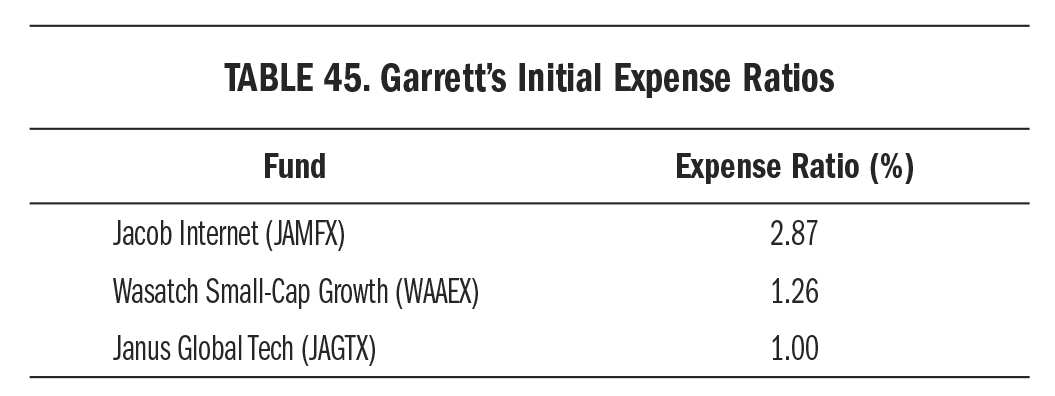
Visit (http://bit.ly/1CmAAA9) for a larger version of this table.
Well, who knows, maybe he’d get performance so huge it would swamp expense concerns entirely. That’s what the z-vals selling expensive funds always promise. Garrett went into 2001 betting they’d be proven right by the recovery dead ahead, and he’d be made richer.
Selma took a different approach. She’d become very cautious with her meager savings after the dot-com meltdown cost her her job and a big piece of her retirement account. In a fresh start, she wanted to minimize danger to her savings. After she landed the new job at SnapSheet, she met with a financial planner at her church and told her she wasn’t sure she wanted to own any stock funds in her retirement account. Not one. “Not owning stocks in your retirement account is like not planting flowers in your flower bed,” the planner told Selma. “Flower beds are for flowers, not just ground cover. Retirement accounts are for stocks, not just bonds. If you put nothing but bonds in your retirement account, it’ll be as dull as a flower bed without flowers.” Selma thought dull sounded pretty good compared with the fireworks since March, but she got the planner’s point.
The planner took Selma through a series of questions to determine her risk tolerance, even though Selma quipped, “Let me save you some time: low.” After the questions confirmed Selma’s prediction, the planner overruled the result and suggested that Selma put 80 percent of her retirement capital in stocks. Selma felt queasy about this. She had a lot of working years in front of her, though, and the planner said that, in the long run, stocks always recover, so Selma took a deep breath and grudgingly agreed to put 80 percent of her retirement in stocks.
As was her way, she carefully researched at the library over several weekends. She printed out fund ratings from Morningstar for each of SnapSheet’s 401(k) offerings that appealed to her. She read articles and a seemingly endless collection of fund rankings. “Funds That Go up When the Market Goes Down,” “Three Top-Rated Growth Funds for the Long Haul,” “The Best Low-Volatility Funds for Gun-Shy Investors,” and similar fare usually featured a few comments by the managers of the winning survey, photos of them in the office, and then a wrap-up along the lines of the manager having “stood the test of time” or being a “veteran of the markets” or “battle-hardened,” unless the manager was new, in which case he or she “showed promise” and would probably “breathe new life into performance.” It was overwhelming at first, but Selma was no dummy and quickly detected repeating patterns and began grouping her options in a way that made them easier to rank and assemble.
She wanted to put the bulk of her capital in large-cap U.S. stocks, which she came to see as the most basic way to gain exposure to the stock market. She wasn’t interested in specializations or any type of focus, just the reliable blue chips that comprise the backbone of the market. Among such funds in the SnapSheet plan, she settled on Fidelity Growth & Income and Longleaf Partners as the best choices.
Fidelity Growth & Income garnered rave reviews at the end of 2000 for having wisely limited its exposure to overvalued tech stocks. Manager Steve Kaye positioned the portfolio defensively going into the tech wreck, owning bargain-priced health care companies and steadily growing financial stocks instead. Morningstar analyst Scott Cooley concluded in November 2000 that Kaye’s “low-turnover, cautious approach has served shareholders well for the long haul. During his nearly eight-year tenure, the fund has roughly matched the S&P 500’s return while exhibiting less risk than the index. In short, this still looks like a solid core holding for conservative investors.” That sounded perfect to Selma, who was certainly conservative. She would put a quarter of her retirement in Fidelity Growth & Income.
Similarly conservative, the manager of Longleaf Partners, Mason Hawkins, came off as a wise grandfather figure who would steer Selma’s account higher through whatever happened next. He had incentive to do so because he and others on the team were required to keep all their invested assets in the firm’s funds. Selma liked this. Longleaf Partners actually gained money in the second quarter of the year, when almost everything else had been crashing from the Nasdaq peak in March, and Hawkins told The New York Times in July, “We have not changed the way we do things for the 26 years that we’ve operated.” His fund was highly rated, and he was highly respected, and seemed about as far away from the flash-in-the-pan Internet madness as one could hope to get. Morningstar analyst Christopher Traulsen wrote in August that what the fund did best was “scour the market’s unloved for diamonds in the rough, buy them cheap, then hold tight until everybody else catches on.” From the Nasdaq peak to the end of November, Longleaf Partners rose 34 percent. No doubt about it, Hawkins was her man. Selma would put a quarter of her retirement in Longleaf Partners.
As for the other 30 percent of Selma’s allocation to stocks, the planner recommended international funds. “They can zig when the U.S. zags,” she explained. Among international stock funds in SnapSheet’s 401(k), two caught Selma’s attention: Artisan International and T. Rowe Price International Stock Fund.
Mark Yockey had been in charge of Artisan International since 1995. Media offered nothing but praise for his stewardship. He told interviewers about his belief in fundamental value and how his team looked for companies that could grow for decades. They hunted long-term trends and then found companies sporting the best business models to benefit from them. The cheapest among those comprised the sweet spot of the global market, the stocks Artisan wanted to own.
Morningstar analyst Hap Bryant wrote at the end of March that the fund “finished 1999 in the foreign-stock category’s top quintile, thanks to big stakes in technology and telecommunications stocks,” and he credited Yockey’s growth strategy for this. In October, analyst William Samuel Rocco added, “This fund continues to handle whatever the world’s markets throw its way.” He noted that it “encountered anything but favorable conditions in 2000” and that “Yockey slashed the fund’s telecom exposure in March” and “found opportunities in the media and financial sectors.” Rocco continued:
Thanks to these moves, the fund, unlike many of its growth-oriented peers, hasn’t relinquished the big lead it established early in the year (when telecom and tech stocks flourished). Despite posting a loss, it’s ahead of 75 percent of its rivals for the year to date through October 23, 2000. The fund has outpaced even more of its rivals over the long term by placing in its group’s top decile three times in the past four calendar years.
This was all very encouraging, but the part that really cemented Artisan International into Selma’s portfolio was an aside near the end of Rocco’s report, that “the fund has suffered only average volatility along the way” and that its expense ratio was declining. She’d put 15 percent into it.
The other 15 percent of her foreign stock allocation would go into T. Rowe Price International Stock Fund. Rocco wrote in November that it had “been an incredibly steady performer in the past,” faring well in “the sell-offs of 1990 and 1994 as well as the robust rallies of 1998 and 1999” such that it had “outgained its average peer by about one percentage point per year during the past decade.” Best of all, as far as Selma was concerned, Rocco considered the fund to be “a solid option for those who are seeking a conservative foreign-stock holding.”
Her remaining 20 percent she would put into bonds, half of it in Oppenheimer Global Strategic Income Fund and half in PIMCO Total Return.
Morningstar’s William Harding reported in October that the Oppenheimer fund’s “eclectic mix of bonds has produced good results so far in 2000.” It was the fund’s safety that appealed to Selma, with its eight hundred issues “limiting the impact of individual disasters.” Harding wrote that its five-year returns landed it in the top third, “while its volatility has been below the group’s norm. Seasoned management and a hefty yield are two more reasons to consider this offering.” Selma would more than consider it; she would put 10 percent of her account into it.
Like Hawkins at Longleaf, Bill Gross at PIMCO Total Return was a legend in the business. Sarah Bush at Morningstar wrote in March, “When manager Bill Gross acts, the investment community tends to take notice.” He’d loaded up on long-term Treasuries ahead of a buyback, which he said would shrink supply and drive up the prices of the bonds he bought, and that’s exactly what happened. His success over the years had been driven by identifying and exploiting such anomalies. Bush wrote that “despite the occasional misstep, this fund has consistently outperformed both its index, the Lehman Brothers Aggregate and its intermediate-term bond peers. With a 10-year return that ranks among its group’s best, it’s no surprise that when Gross talks, the bond market listens.” From the Nasdaq peak to the end of November, PIMCO Total Return rose 9 percent while paying a dividend of about a nickel per share every month, for a total of $0.48 paid over nine months. Selma would put 10 percent of her retirement under the guidance of Bill Gross.
Selma liked the bond market’s steadying influence on a portfolio, especially in conjunction with her fairly safe stock fund choices. Surely, she thought, with a quarter of her money run by the legendary Mason Hawkins and 10 percent of it run by the legendary Bill Gross, she’d be fine. That was more than a third of her retirement allocated to legends in the business, and two-thirds allocated to other well-respected managers known for above-average returns from only average or below-average volatility.
Selma did a good job. Her portfolio was sensible. Her $405 per month would be divided among the six funds in the same allocation as her initial mixture, for steady, reliable growth. She knew the dollar-cost averaging would help her take advantage of price swings without needing to worry about eventual recovery. Her top-notch managers would see to that. One thing she didn’t pay close attention to was the cost of her portfolio, which is easy to overlook among glowing reports on legendary and well-respected managers. Here’s what she paid:
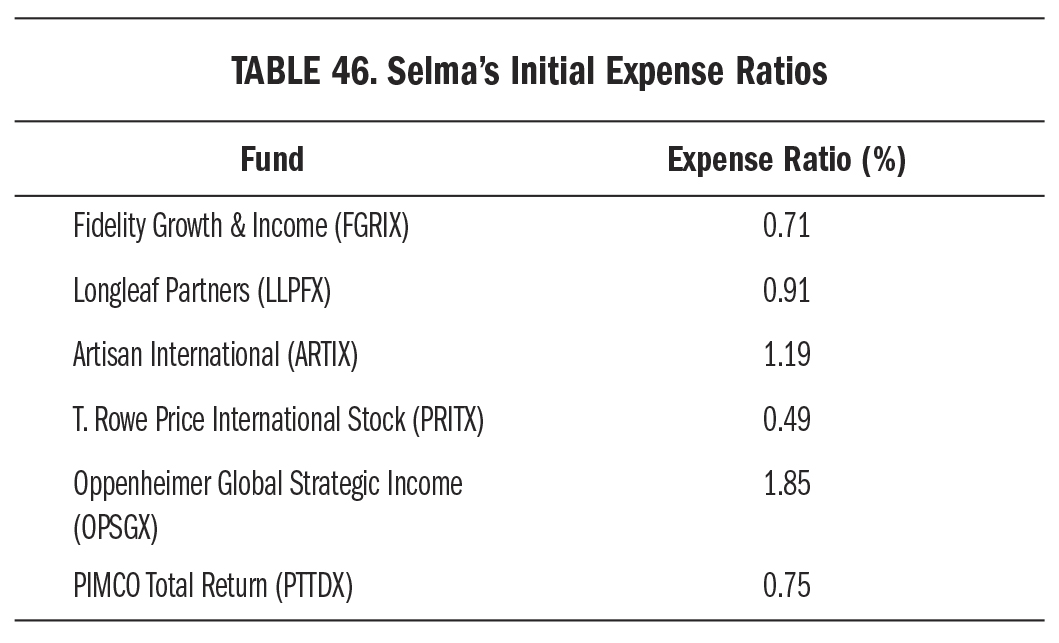
Visit (http://bit.ly/1CvkzYY) for a larger version of this table.
This is better than what Garrett faced in the expense department, but still far above the tiny fees associated with index funds. Also, the Oppenheimer fund included a deferred sales load that Selma would have to pay if she sold shares within six years, but she ignored it because she knew the account was for the long haul and because the financial adviser had said Oppenheimer was well known in the business and quite popular. Selma figured that if anybody could earn the higher charges, it was the six first-rate management teams she’d selected. The final solidifying input from the financial planner was that Selma’s allocations to domestic stocks, international stocks, and bonds was correct for her age, and the diversification into two funds for each asset class provided further safety. “There’s no optimum number of funds,” the planner said, “but your six look very good for your temperament and time horizon.” Great! Selma was set.
Mark’s plan was the easiest to start. He’d concluded in the years before joining SnapSheet that active management wasn’t for him, regardless of rave reviews and glowing reputations. After he discovered the low-cost advantage of index investing and the fact that it beats almost all active managers, he set about finding the best way to grow an index fund portfolio. The only two approaches that appealed to him were dollar-cost averaging and 3Sig. He’d gone with dollar-cost averaging in a diverse mix of stock index funds at his former employer. The portfolio grew like clockwork in the late 1990s, but then he entered the dot-com crash fully invested and unable to do anything but watch his portfolio melt away. Had he sold at the peak a year earlier, the end of 1999 or even sometime in early 2000, he’d have been fine. When prices began retreating, though, he knew it was the time to keep going with his monthly purchases, so he did. The problem was, they were so small in comparison to the thousands disappearing monthly from his account. He found himself wishing he’d had some real buying power into the depths of the crash, and that’s when he remembered 3Sig.
He’d sold all his stock funds and hid out in cash during his unemployed months before SnapSheet, worried for his wife and three children the same way Selma worried about her two children. While job-hunting, he consolidated everything he had in the safest place possible. Once he was hired at SnapSheet, he turned his attention to the new 401(k) at his disposal and again faced the trade-offs between dollar-cost averaging and 3Sig. “What really went wrong?” he asked his wife at the dinner table one night in their new home, after the kids had been excused.
“The market crashed,” she replied.
“I know, but if that’s what markets do now and then, and if it craters my retirement account every time, then I’m doing something wrong.” She offered that maybe they should own safer investments. “That could work,” he agreed, “but then we end up underperforming most of the time, when the market rises.” He reminded her of 3Sig, how it would keep them mostly invested in high-performing small caps, but with a 20 percent bond buffer to be able to “really wade in when the market collapses, like this year,” he said. He thought that was about the best balance they’d be able to strike—plus, it was easy to do.
With that, he set up 3Sig in his SnapSheet 401(k). He divided his initial $10,000 along the 80/20 stock/bond allocation you now know well. Since SnapSheet’s plan included iShares Core S&P Small-Cap (IJR) among its choices, and it was the cheapest small-cap index vehicle in the plan, it’s what Mark would use for the stock side. For the bond side, SnapSheet’s plan included Vanguard GNMA (VFIIX), so he’d use that for the 20 percent safe portion of the plan. He’d begin 2001 with $8,000 in IJR and $2,000 in VFIIX. He would build half his $1,215 quarterly contribution into the 3 percent quarterly signal target, leaving the other half in bonds for buying power. If his bond allocation ever reached 30 percent of his account, he would move the extra into IJR on the next buy signal. If the market ever dropped 30 percent on a quarterly closing basis, he would enter the “30 down, stick around” mode and ignore the next four sell signals. That was it. Here’s what he’d pay in expenses:
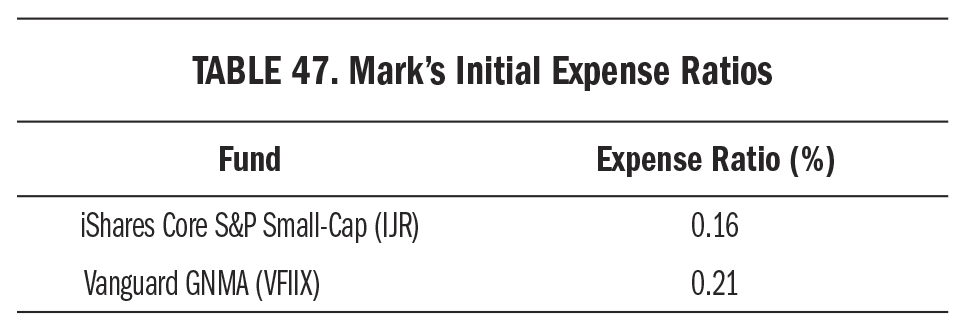
Visit (http://bit.ly/1yZgBrZ) for a larger version of this table.
Mark’s allocation-adjusted expense ratio came to 0.17, some 92 percent less than Garrett’s 2.00 and 82 percent less than Selma’s 0.92. Already his portfolio enjoyed a distinct advantage. Garrett and Selma didn’t know this, however. Z-val commentators, Peter Perfect, and active managers promise investors that higher fees are more than overcome by better performance, an opinion straight from the old “you get what you pay for” philosophy. Time would tell.
With these preparations, our three investors were off and running at their new jobs with their new 401(k) plans.
Year 1
Everybody’s salary and retirement contributions stayed constant in their first year on the job. The dot-com crash wasn’t quite over yet, it turned out, and the year would introduce a major disruption in September: the 9/11 terrorist attacks.
April 2001
Trouble began early for Garrett. At the end of March, his initial $10,000 plus his three $405 monthly contributions had fallen to an account value of $7,629. At lunch with Selma and Mark, he vented. “I’m down almost twenty-four percent, and that includes the twelve hundred fifteen dollars in new money. I thought Jacob Internet was going to scream higher, and it did in January, with an eighteen-percent gain, but now it’s down forty-six percent since the end of last year when I bought it. I thought the dot-bomb crash was over!”
“You should switch to something safer,” Selma said. “I got burned by Internet junk a year ago, too, so I put together a steadier fund mix this time.”
“I don’t want steady,” Garrett said. “I want excitement.” He chuckled. “Anyway, I’m not doing much better in my other funds. In the first quarter, Wasatch Small-Cap is down eleven percent, and Janus Global Tech is down thirty percent.”
“I don’t know how you stand it,” Mark said. “What are you going to do?”
“Not sure yet. Analysts say tech profits are still bad, and a lot of them think the economy and all corporate profits, not just tech, are going to stay bad all year. I’m thinking I should get to the sidelines and buy back in later, when prices are lower. What about you guys?”
“I’m not doing anything,” Selma said. “My planner and I put together a good portfolio of six funds. My Oppenheimer and PIMCO bond funds paid dividends, and so did Fidelity Growth & Income. I automatically reinvest dividends into the fund that paid them. My funds are safer than yours, so rough quarters like this one don’t do much to them. The dividends and my cash contributions build on top of steady gains. I finished the quarter up five percent overall, so I’m pretty happy.”
Garrett didn’t look happy to hear this, and reiterated his belief that he could catch up later in the year if he got to the sidelines and reentered at lower prices.
“But isn’t that what you tried in December?” Mark asked. “I remember your saying the dot-com crash had made tech stocks so cheap that you wanted to focus on them. Now they’re cheaper. If your goal was to invest in cheap tech stocks, wouldn’t it be better to keep buying the funds you own at these lower prices?”
“Sure, if they’re going to go up soon, but not if they’re going to keep going down. I guess I could play that game forever, couldn’t I? I’ll stay put for a while, keep my contributions steady. What about you, Mark?”
“I just did the only thing I’ll ever do,” Mark replied. Garrett and Selma looked over at him. “No, really. I follow the same procedure at the end of every quarter. I see if my stock fund achieved its three-percent growth goal plus half the cash I contributed to my bond fund for the quarter. If so, I do nothing. If not, I use money from the bond fund to buy the stock fund up to the target balance. If the stock fund is over the target, I sell it down to the target and put the proceeds into my bond fund. That’s all.”
“What did you do this time?” Garrett asked.
“Bought more of my stock fund. It fell six percent, so it missed the target balance for the quarter. The bond fund did fine, though, up almost three percent for the quarter and paying dividends, so I had plenty of cash to catch the stock fund up to its target. My account finished the quarter about eight percent higher.”
“Those are good funds,” Garrett said.
“They’re just indexes. My stock fund tracks the S&P Small-Cap Six Hundred Index and my bond fund owns government GNMAs. Nothing special, and no human judgment involved. I like that. People have terrible long-term track records against indexes; plus they charge more.”
“My fund managers are some of the best in the business,” Selma said. “They beat the indexes. Managers are ranked, you know, so it’s easy to choose good ones. Mine are highly rated.”
“Yeah, Mark, not all people have terrible long-term track records against indexes,” Garrett added.
“Maybe not all, but how’s yours shaping up?”
September 2001
The September 11, 2001, terrorist attacks shut down the stock market for a week. When it reopened, prices fell sharply, sending poor Garrett’s portfolio to the mat yet again. On the first day of trading after the attacks, Monday, September 17, the Dow fell 7.1 percent and posted its largest single-day point drop in history to that time, and the Nasdaq fell 6.8 percent. Jacob Internet lost 27 percent in September alone, and was off 71 percent for the year. Wasatch Small-Cap Growth was down 6 percent for the year, Janus Global Tech 54 percent. Even though Garrett kept buying the cheaper prices with his monthly contributions, his account value had slipped 26 percent since the beginning of the year.
During a lunchtime walk in a park near the offices, he told Selma and Mark that the amount of money he’d lost in the first nine months of the year wasn’t just the $2,629 difference between his initial $10,000 and his current $7,371 balance. “No, I have to include all my monthly contributions, too.” Run $405 per month for nine months and you get $3,645. He pulled a slip of paper from his pocket. “Total lost, then: six thousand two hundred seventy-four dollars. I’m starting to really hate stocks. First the never-ending dot-bomb bust, now the attacks. Oh, and by the way, Mark, thanks for your swell advice to keep buying cheaper prices back in April.”
“Hey, now,” Mark said. “That’s not my fault. I was just telling you what my signal said, which was to buy more. I bought then, too, you know.”
“Didn’t you sell over the summer, though?” Selma asked.
Mark nodded. “The signal said to sell a bit of my stock fund at the end of the second quarter, yes.”
“How about now?” Garrett asked.
“A big buy signal, what else? You’re not the only person whose stocks are falling. My stock fund dropped sixteen percent last quarter.”
“After you sold the previous quarter?”
“Right.”
“Now you’re going to buy more?”
“Yeah, almost twenty-five hundred dollars more. It’s a big buy signal, at least for me.”
“So, let me guess: you think I should buy more, too.”
“I don’t think anything, Garrett. I just follow the signal. It’s telling me to buy a lot more, so I will. Besides, even if you wanted to buy more, you don’t have the cash, right?”
“Thanks a lot.”
“No, I’m just asking. Is it even an option to buy more?”
“I could at least keep my monthly contributions buying more, but I might not,” Garrett said. “I’m getting fed up with this. The chief economist at Wells Fargo said the attacks have hurt consumer confidence, and it’s costing billions in business activity. I tell you what, my confidence sure is hurting. I’ve just had it.” He walked quietly for a moment. “But your signal says to buy now, right?”
Mark nodded. He didn’t want to say much, preferring just to report the signal. Wasn’t Garrett hearing enough noise as it was?
“I’m keeping my plan going,” Selma said. “I didn’t actually lose badly last month. Artisan and Longleaf went down something like twelve and thirteen percent, but PIMCO gained. With my regular contribution and the dividends, my account value dipped only five percent. It’s important to keep buying when the market dips, Garrett. You pick up more shares on the cheap.”
“I know, I know, but see how you feel when cheap gets cheaper, and cheaper, and cheaper.”
Garrett couldn’t stop thinking about it. He watched investment reports on TV, read investment websites, and devoured the most recent issues of the newsletters he received. His wife mentioned that they were the same newsletters that thought buying cheap tech a year ago was a good idea, and he admitted as much, but said just as all the bears were eventually proved right at the end of the dot-com bubble, so the bulls would eventually be proven right at the end of the current bear market. He wanted to change something but didn’t want to miss out on the big recovery that he just knew lay ahead.
His thinking was confirmed by the media and newsletters. The BBC reported that the “souring U.S. economy further weakened by the recent attacks on the World Trade Center in New York and Washington has erased billions of dollars of wealth among U.S. investors. Many have reacted by pulling what remains of their worth out of stocks and mutual funds, further exacerbating a desperate situation.” As much as he hated the sound of that, he was determined not to join them in the exit stampede. Some analysts suggested it was a perfect time to put fresh money to work. Garrett didn’t have fresh money, but he could rearrange what was already invested.
He was eager to get out of Jacob Internet, even embarrassed to say he ever owned the thing, now down 71 percent year-to-date. Was there a way to bail out of the Internet’s journey to the center of the earth without losing all recovery potential? He thought so when he read that the stock market can do well in a time of war, which the United States entered with a retaliatory strike on Afghanistan and something bigger cooking in Iraq, by all early indications. Apparently, when the United States does well in a war, stocks rise, and nobody expected anything but a positive outcome in whatever Middle East wars resulted from the terrorist attacks. So he should own stocks. Which ones? Airlines.
That’s what one of his newsletters suggested as the sector most poised for a rocket off the bottom. Airplanes were used in the attacks, air transportation was locked down in response, big changes in security procedures were on the way, so airline stocks and related stocks crashed. They wouldn’t disappear, the newsletter said; they would rebound big time when people started traveling normally again, and airlines might even get a helping hand from government. The letter recommended a list of airline stocks, and also the Fidelity Select Air Transportation Portfolio “for investors who’d rather own a basket of stocks than individual picks.” That was it! Garrett would replace Jacob Internet with Fidelity Select Air Transportation Portfolio.
He got on it right away and began Q4 with his new portfolio. On top of what he hoped would be better appreciation potential—how could it be worse?—he would save on expenses. The fee at Jacob Internet had been 2.87 percent. His new Fidelity fund’s expense ratio was only 0.94 percent. With half his capital allocated to this part of the portfolio, the discount represented a big savings. This was his new portfolio’s expense structure:
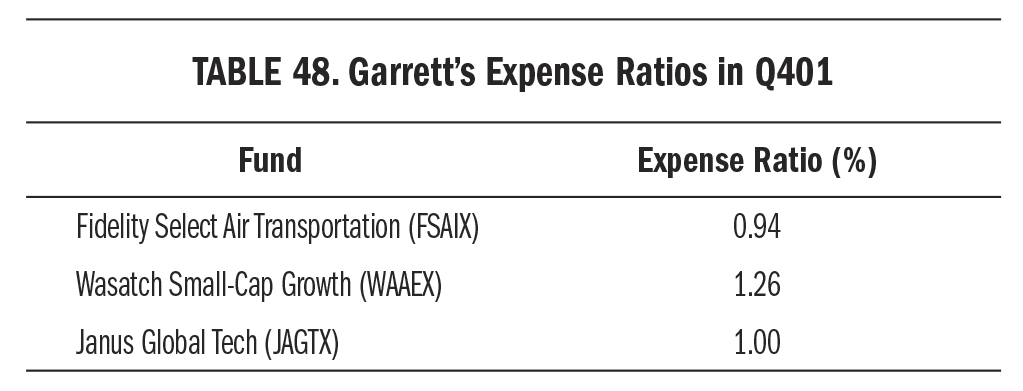
Visit (http://bit.ly/1CZZ2FU) for a larger version of this table.
As Garrett stayed up late researching and weighing his options, discussing the market with his wife, debating whether war was good or bad for stocks, then which stocks in this particular brand of war would do well, his colleagues did almost nothing.
Selma did literally nothing, allowing her dollar-cost averaging plan to work its magic on the six reliable funds. Terrorist attacks or no, her $405 went into her portfolio per the usual allocations, and she didn’t give stocks another thought after the lunchtime walk with Mark and Garrett.
Mark already knew his signal line for the quarter, which was always 3 percent higher than the previous quarter’s balance in his stock fund, IJR, plus half his quarterly contributions into his bond fund, VFIIX. That quarter, the signal line was $10,620. At IJR’s closing price of $95.50 (unadjusted), he needed 111 shares of IJR. He owned only 85, so he would buy another 26 shares, which would require $2,483. He sold that amount of his bond fund and bought the 26 shares of IJR. He glanced at SPY to see if it had fallen enough to trigger the “30 down, stick around” rule, and saw that it hadn’t. Then, like Selma, he didn’t give the market another thought.
December 2001
At the conclusion of their first calendar year at SnapSheet, these were the retirement account balances of our three investors:
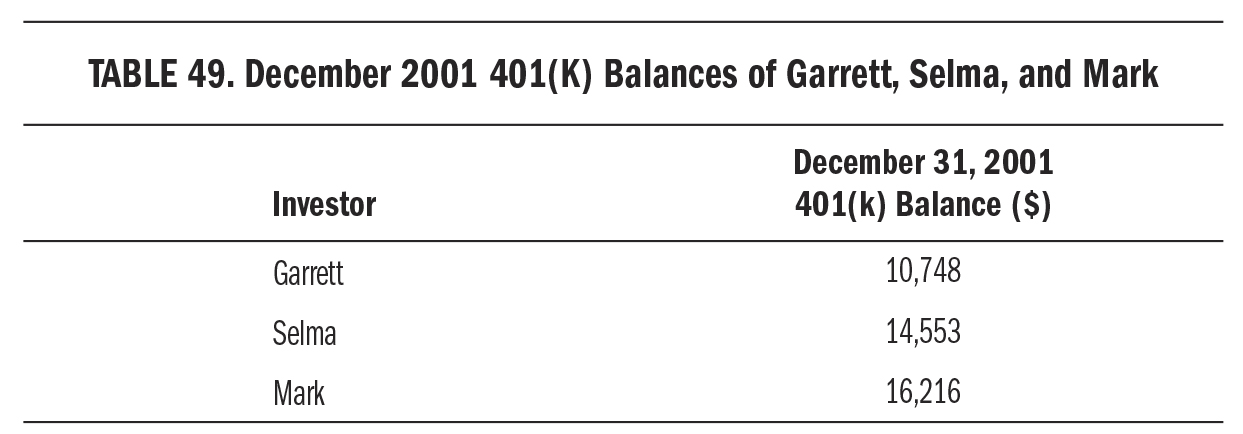
Visit (http://bit.ly/1zDT27W) for a larger version of this table.
The Dow Jones Industrial Average lost 7 percent in 2001. On top of the terrorist attacks, investment media fretted about the bankruptcy of Enron, with The Economist writing at the end of November that the situation had gone from the firm having a stock market valuation of $60 billion in February to shareholders set for nothing after its bankruptcy. Barely a year earlier, Enron founder Ken Lay was “being touted as the next energy secretary,” but now “his career as an innovative entrepreneur has ended in failure.”
“That’s an interesting sideshow,” Garrett thought, but he was more concerned with his new sector fund, Fidelity Select Air Transportation Portfolio, which gained only 21 percent in the fourth quarter. Jacob Internet, the fund he’d replaced with Air Transportation, gained 51 percent. Even the other funds he kept did better than Air Transportation. Wasatch Small-Cap gained 30 percent, and Janus Global Tech gained 31 percent. He still felt good to be finished with the Internet, but wished he’d held on longer before making the switch.
At least advisers suggesting airline stocks were still bullish. The International Air Transport Association said its Corporate Air Travel Survey had discovered an optimistic business community, with 57 percent of respondents expecting normal travel conditions to resume within six months. Garrett thought this had to be good for airline stocks, so he would hold on to his three funds for a payoff someday.
The fourth quarter was pretty good to Selma. Artisan International gained 9 percent and paid $1.06 in dividends, while Longleaf Partners gained 13 percent and paid $0.52 in dividends. She glanced at her account balance before heading off to a New Year’s Eve party with her children, thought it looked good, and promptly forgot about it.
Mark ran his usual procedure at quarter’s end and was happy to get a decent sell signal, thereby vindicating the previous quarter’s big buy signal. IJR gained 20 percent in the fourth quarter, generating a $1,176 sell signal, which he entered. He would later move the proceeds of the sale into his bond fund. After fifteen minutes of easy calculations and a couple of orders, he was done for the quarter.
Year 2
Everybody’s salary increased by 5 percent in January 2002, to $56,700 per year, or $4,725 per month, pushing their monthly 401(k) contributions to $425 after the employer match. The year would mark an increasing fever pitch in President George W. Bush’s war on terror in Iraq, Iran, and North Korea, which he called collectively “an axis of evil” in his first State of the Union address, and outlined three goals: winning the war, protecting the homeland, and conquering the recession.
It was another ho-hum quarter for Garrett, with Air Transportation up 12 percent but Wasatch Small-Cap down 4 percent and Janus Global Tech down 7 percent. His overall balance, including monthly contributions, rose 13 percent for the quarter, to $12,137. He looked at it positively, though, impressed with his own good judgment to have focused on airlines as they accelerated into a strong recovery. “I’ve figured out a thing or two,” he told his wife over dinner. She asked if he was thinking of taking profits from the “airplane fund.” He said, “No, not yet. I want to give it room to run.” He’d read in Investor’s Business Daily that it’s important to keep winners. Air Transportation was definitely a winner, so he wanted to keep it.
Six months had passed since 9/11. The Associated Press reported, “The Dow has climbed 28.9 percent since its post-attack lows, the Nasdaq is up 35.6 percent and the S&P has advanced nearly 21 percent.” It mentioned that “After two years of unsustainable rallies and tumbling stock prices, there are concerns that some issues have become too expensive given the modest projections for the future. [Some investors] want to hear more companies report improving results before committing too much to stocks.”
Neither Selma nor Mark cared. They paid little attention to the financial media, focusing instead on their family situations. Selma’s account grew 12 percent in the quarter, to $16,243. Mark’s grew 13 percent, to $18,359.
September 2002
In a USA Today article, “Bear Drags Stocks Deeply into Den,” Adam Shell wrote on September 30, 2002, that logic says stocks can’t go down forever, but after watching the Dow Jones Industrial Average sink for three years—nearly 18 percent in the previous three months alone—“countless investors are starting to wonder if stocks will ever go up again.” The Dow and S&P 500 delivered their worst quarterly performances since the fourth quarter of 1987, and the Nasdaq languished at a six-year low.
The z-vals duked it out in the article. The market is “at least in the very late stages of the decline,” said Woody Dorsey, president of Market Semiotics, which specializes in behavioral finance. “We are in a very difficult period, where all of the negative headlines are self-reinforcing.” Bears countered with worries about war in Iraq and “a potentially debilitating bout of deflation” in addition to terrorism, weak corporate profits, and a possible double-dip recession. Until the economy perked up, Donald Straszheim of Straszheim Global Advisors said he expected little more than “sporadic, unsustainable rallies.” Michael Farr, president of money management firm Farr Miller & Washington, said, “The past few years, investors have been rewarded for selling and punished for buying.” Todd Clark, a trader at Wells Fargo Securities, added, “There is an unbelievable amount of pessimism.”
Garrett couldn’t believe it. He flipped through research reports in his home office, looking back at the quarter. Would the stock market nightmare ever end?
A market strategist at Ryan Beck & Co. quipped to the Associated Press, “I think what we’re seeing is a tug of war between one camp looking for the economy and corporate earnings to fall significantly further from where we are, and the other camp looking for the economy to expand . . .” Garrett sighed and pushed back from his computer. “Duh, ya think?” he mocked. “What other choices are there? Here’s an idea: If you don’t know anything, don’t say anything.”
His focused bet on Air Transportation had fizzled, with the fund down 30 percent year-to-date. It had even fallen below what he’d paid for it after the 9/11 attacks, but analysts were still bullish on airlines. “Their day will come,” wrote the newsletter editor who first gave Garrett the idea a year earlier. “We were early, but not wrong.”
“Early but not wrong?” Garrett asked out loud. “Tell that to the guy who walked onto the train tracks after you gave the all-clear. ‘It wasn’t safe then, but it will be later. Sorry.’ Thanks a lot! I’m squashed flat! Sometimes, early is wrong.”
Of course some analysts still said to hold on tight. The recovery that had been “just around the corner” for the past two years was still around the corner. Garrett realized that he was plain sick of it. The same comments from the same people in the same media about the same things hadn’t helped him one bit. He was down and still falling. He knew the best way to guarantee a miraculous market recovery was to sell everything, so he wouldn’t do that. What he would do, though, was stop investing more every month. At least that way, his monthly contributions would build up a buying buffer so he could take advantage of a potentially lower low in the future. If the market didn’t keep falling, he would feel good to have held on to what he already owned. It seemed like a good compromise.
Selma followed her usual action plan, which was to do nothing. Her $425 monthly contribution continued to be divided among her six funds as initially allocated. Even after all the market fuss, her overall account balance including contributions had slipped less than 3 percent since the end of March. No biggie.
Mark followed the signal, as always, but was getting concerned that he might run out of cash. At the end of the first quarter, his bond allocation had hit 32 percent of his account, over the 30 percent threshold, triggering the need to rebalance for the first time. The chance to do so happened the very next quarter, when 3Sig issued the buy signal that gave him the all-clear to rebalance bonds back down to 20 percent.
The market had been bad in that second quarter, pulling IJR down 7 percent. The 3Sig plan issued a signal to buy 16 more shares, or $1,832 worth. Before the order, Mark’s IJR stock balance was $11,712 and his VFIIX bond balance was $7,264. Dividing his bond balance by his account balance of $18,976 showed that he had 38 percent in bonds. He wanted only 20 percent. Multiplying $18,976 by 0.2 showed he should have just $3,795 in bonds. Subtracting this from the bond balance of $7,264 revealed that he should buy $3,469 of IJR instead of the $1,832 indicated by the signal. He sold $3,469 worth of the bond fund, bought the same amount of the stock fund, and began the second quarter with $15,181 in stocks and $3,795 in bonds, perfectly back at the 80/20 ratio that was his target. He then resumed the standard plan, and would stick with it until bonds reached a 30 percent allocation again, triggering another rebalance.
Unfortunately, the market kept falling. Right after the big buy in the second quarter, 3Sig issued another big buy signal, for $3,925 worth of IJR at the end of the third quarter. His contributions to the bond fund had pushed its balance up to $5,204 so he could fund the buy signal, but doing so brought his bond allocation down to only 7 percent. A big enough buy signal in upcoming quarters with no sell signals to help could leave him unable to buy into further price weakness. There was nothing he could do about it, but it reminded him of the idea to keep a bottom-buying account alongside the plan, some extra cash just in case he ever used up his bond fund. He hadn’t set up a bottom-buying account yet. Maybe if he got another raise in the New Year, he would.
December 2002
At the conclusion of their second calendar year at SnapSheet, these were the retirement account balances of our three investors:
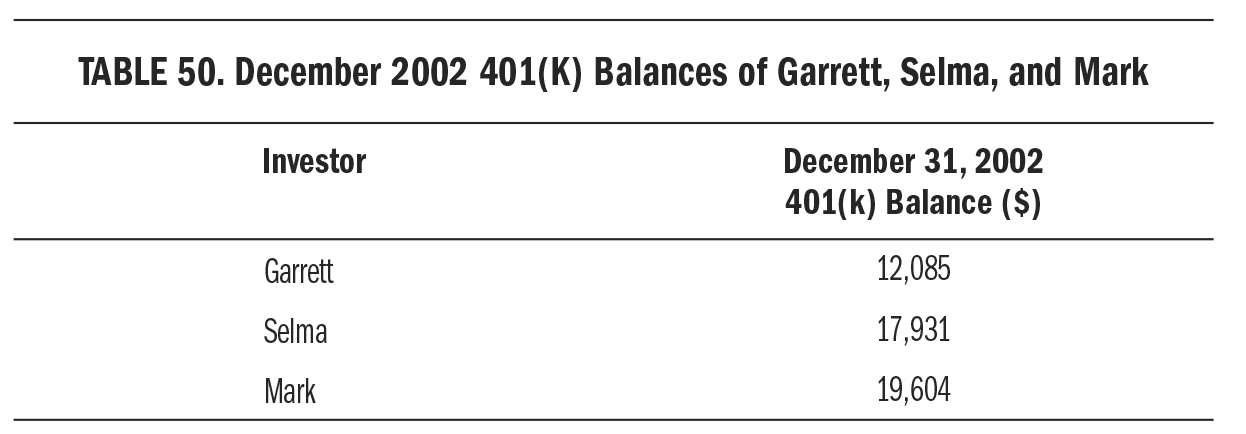
Visit (http://bit.ly/1EaY25o) for a larger version of this table.
After falling 6 percent in 2000 and 7 percent in 2001, the Dow Jones Industrial Average lost 17 percent in 2002. On the Nasdaq, things were much worse: –39 percent in 2000, –21 percent in 2001, and –32 percent in 2002. A Businessweek special report, “Where to Invest in 2003,” began:
Some say Wall Street is a crooked thoroughfare that begins at a churning river and ends in an old graveyard. It’s a fitting metaphor for 2002—the third year of a grisly bear market. There hasn’t been a time in recent memory when the stock market has been so violently roiled, destroying the fortunes of so many. Nor has Corporate America ever been shaken by such an array of scandals. Words like Enron, WorldCom, Adelphia, ImClone, Grubman, Kozlowski, and Fastow have entered the vocabulary as shorthand for corruption and greed. Even Martha Stewart—the Queen of Clean—got her hands dirty in an insider-trading scandal. Things got so bad that Wall Street became a running joke on late-night talk shows. As Jay Leno said: “Do you know the difference between Las Vegas and Wall Street? In Vegas, after you lose your money, you still get free drinks.”
Garrett’s plan to stop investing his monthly contributions felt right. Fidelity Select Air spiked a tad after his decision, but then began falling again in December, down 2 percent. The same happened with his other funds. He liked watching his cash fund build up for the right time to buy later, if there’d ever be a right time. He and his wife set a rule for that year’s Christmas celebrations with family: no stock talk. She was tired of his bad mood that always accompanied such discussions, so asked that they be avoided altogether. He eagerly agreed.
Selma, on the other hand, couldn’t have been happier with her six funds. They kept cooking along, and she continued plowing more money into them every month. All her research two years prior was paying off—the highly rated funds were doing what she’d wanted them to do. If the bear market ever ended, she expected to really see some gains.
Mark was also happy, but a tad nervous about his low bond fund balance as he kept using it to satisfy 3Sig’s buy signals in the bear market. From 7 percent at the end of the third quarter, it rose to 11 percent at the end of the fourth. At least it was rising, but seeing it fall below 10 percent bothered him. He decided he would definitely open a bottom-buying account in the New Year, just to be safe.
Years 3–7
In each of the years 2003 to 2007, everybody’s salary increased by 5 percent. All three of our investors were good at managing their personal finances, and decided to set aside 4 percent of their gross salary in a savings account at SnapSheet’s credit union. They took the modest dividends from these savings accounts out as bonus spending money for a little fun, leaving the balance in the accounts growing at just the pace of their contributions. Here’s how these factors looked over the five years:
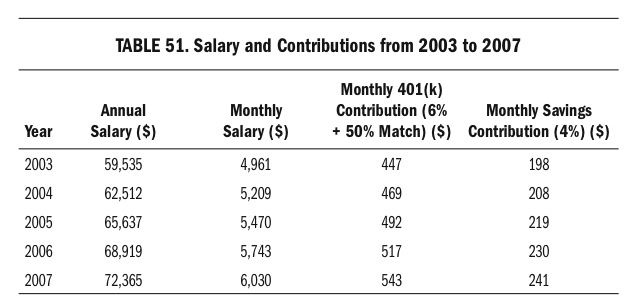
Visit (http://bit.ly/1zDT3Zl) for a larger version of this table.
All three considered their savings to be rainy-day funds, but Mark assigned his the extra role of bottom-buying account for his 3 percent signal plan. He soon forgot all about this, however, because after the second quarter of 2003, his bond balance stayed in a comfortably high range, growing from his contributions and the plan’s signals. He kept setting aside 4 percent of his salary as savings, but stopped regarding it as a bottom-buying account to be used if he exhausted his bond fund balance. In the bull market finally under way, there looked to be little risk of a steep crash.
The period didn’t begin as a bull market under way, though. It began with all kinds of uncertainty.
March 2003
The first quarter of 2003 was dominated by the lead-up to war with Iraq. President Bush declared March 17 to be the “moment of truth” for the U.N. Security Council to tell Iraq to disarm immediately or face invasion. Nothing happened at the United Nations, and Iraqi president Saddam Hussein refused to step down, so the United States bombed Baghdad on March 19. The next day, ground troops invaded Iraq. On March 22, the well-announced “shock and awe” air strikes commenced. Finally, the war was under way. During the uncertainty ahead of it, the Dow fell 14 percent from mid-January to March 12. As soon as the start of the war looked imminent, the market turned up.
Garrett, for one, felt like a genius. With nothing but talk of war everywhere the previous Christmas, he’d followed the advice of a cyclical-timing newsletter and switched his Fidelity Select Air Transportation money to the Fidelity Select Defense & Aerospace Portfolio. The fund’s focus on the defense industry not only stood a good chance of thriving in what looked to be a protracted war ahead, given the lack of objectives, but it also charged an expense ratio of just 0.84 percent, compared with 0.94 percent at Select Air.
In the prewar drumbeat, Select Defense fell only 8 percent in the first quarter, compared with Select Air’s 9 percent drop. The slip back was a welcome development for Garrett, who still hadn’t resumed investing the monthly contributions he’d been keeping in cash since the previous October. At the end of a six-month hiatus that saw his cash balance grow to $2,616, he was pleased as punch that he hadn’t lost as much as he would have if he’d kept investing every month. His timing was vindicated, and his confidence increased. To make the move perfect, he just had to deploy his cash at the right moment—and he had a feeling that right moment was upon him. Most of his newsletters said the start of the war would be the start of a bull market. The war had started, and he already owned the only defense industry fund on the market. Bulking up his position in the fund at a low price point in the cycle would make it even better, so he decided to put all $2,616 of his cash into Select Defense at the end of the first quarter of 2003 and resume his regular monthly purchases, too. He’d called the winds of war correctly, and it was finally time to catch up.
Morningstar analyst Kerry O’Boyle confirmed Garrett’s bullishness on Select Defense in a March 18, 2003, review titled, “This Unique Offering Continues to Shine in the Shadow of War,” which began:
Fidelity Select Defense & Aerospace has been drawing quite a bit of attention lately. As the only sector fund devoted exclusively to the defense industry, it can be viewed as a leading candidate to benefit from a war with Iraq. But that would ignore the fund’s long-term outlook, especially with regard to defense-spending trends. Manager Matthew Fruhan thinks that the military is only midway through a building boom required to replace aging equipment, a buying spree that has only accelerated since the Bush administration took office. Whereas a war may provide a short-term boost to defense stocks, it’s this spending cycle that drives defense-company profits.
As Garrett maneuvered his money to benefit from news trends, Selma’s all-star portfolio kept doing everything right, so she continued her tradition of merely glancing at its improving balance and doing nothing. Despite market gyrations in what O’Boyle called the “shadow of war,” Selma’s portfolio with contributions grew 4 percent in the first quarter. She happily noted that, at the current pace, it would soon exceed $20,000 for the first time.
Mark had been watching for SPY to activate the “30 down, stick around” rule in the bear market, and it did so in the third quarter of 2002, by finally slipping under the price that was 30 percent below its quarterly closing high of the previous two years. SPY closed 2000 at $131.19 (unadjusted), putting the rule’s 30 percent level at $91.83. When it closed in September 2002 at $81.79, the level was convincingly breached, instructing Mark to stick around in IJR by ignoring 3Sig’s next four sell signals. The market did badly for two more quarters, causing 3Sig to issue buy signals. The current one forced Mark’s bond balance back down to 7 percent.
That was the last quarter for a long time that a low bond balance would worry him, though. From the $91.48 he paid for IJR at the end of March 2003, its price would rise 74 percent, to $158.85, in the following two years, starting the period with four sell signals in a row that he would ignore per the “30 down, stick around” rule, as his stock and bond balances both rose. IJR would then split three-for-one and go on to rise another 29 percent in the next two years. He had no way of knowing this in advance, of course, and the news continued launching noisemakers every step of the way higher. He didn’t care about that, though. The beauty of 3Sig was that it wasn’t waylaid by worrywarts.
December 2004
At the conclusion of their fourth calendar year at SnapSheet, these were the retirement account balances of our three investors:
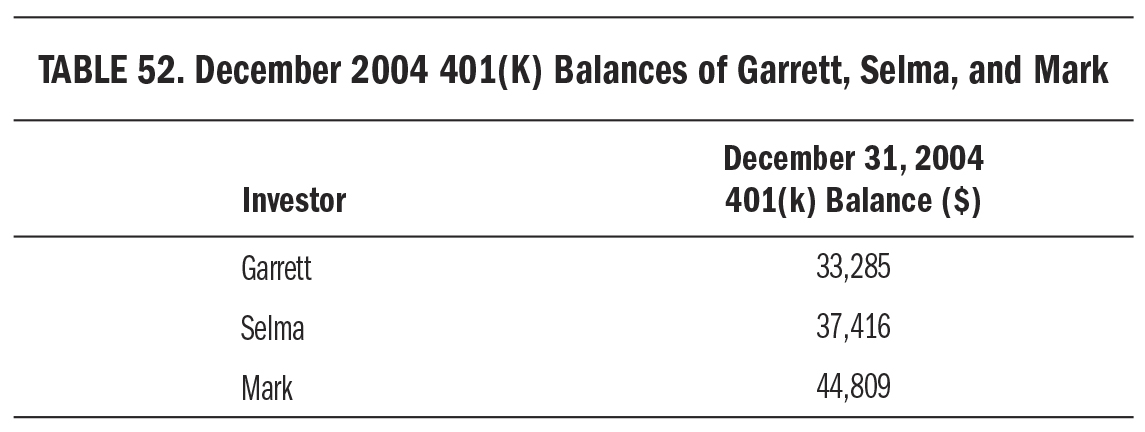
Visit (http://bit.ly/1yDAWRG) for a larger version of this table.
Until he compared balances with his colleagues at a holiday party, Garrett had been confident in his portfolio. Select Defense went gangbusters as the Iraq War dragged out. After President Bush changed the war’s objective from finding nonexistent weapons of mass destruction to building democracy in a country that didn’t want it, defense analysts became giddy with glee because such a mission would never be accomplished. What could be better for defense profits than a war without end? Garrett’s extra investment in Select Defense back in March 2003 paid off as the fund rose 78 percent by the end of 2004. His other funds did well, too. In the same time period, Wasatch Small-Cap grew 61 percent and Janus Global Tech grew 52 percent. Yet here he was way behind Selma and Mark, who never did anything interesting in their accounts.
He dove back into his market research and discovered an energy newsletter pushing oil refiners and drillers because their shares had done well recently. Then he found Richard Bernstein, the chief U.S. strategist at Merrill Lynch, telling Businessweek that stocks would go up only a little in 2005, about 1 percent plus a couple of percent from dividends. “It could be a rough ride even for that,” Bernstein warned. “The Federal Reserve is going to be tightening short-term interest rates at the same time profit growth is slowing down to about half the 18 percent we’ve been getting in 2004. That’s a coincidence that never ended well under [Fed chairman Alan] Greenspan. It contributed to the early-1990s recession, the 1998 financial crises, the deflation of the tech bubble, and the last recession.” He liked the energy industry because “prices will cycle up and down, but the secular trend is higher.” He suggested avoiding refiners and drillers. “It is better to hide out with big, reliable guys like ExxonMobil.”
After serious thought and dinner conversations with his wife, Garrett decided he would sell his position in Janus Global Tech, his overall laggard, and put the proceeds into ExxonMobil stock. He’d keep his monthly contributions divided up the same way, with half going into Select Defense and a quarter into each of Wasatch Small-Cap and his new ExxonMobil holding. Maybe his problem had been too much diversification, he thought, and by concentrating a portion of his account on a single stock, he would do better. After all, Bernstein called energy “the No. 1 story for the decade” and seemed to think ExxonMobil would lead it. The stock had nearly kept up with Janus Global Tech since March 2003, and paid a steady quarterly dividend, so Garrett thought its outlook was decent. At the end of December 2004, then, his portfolio became this:
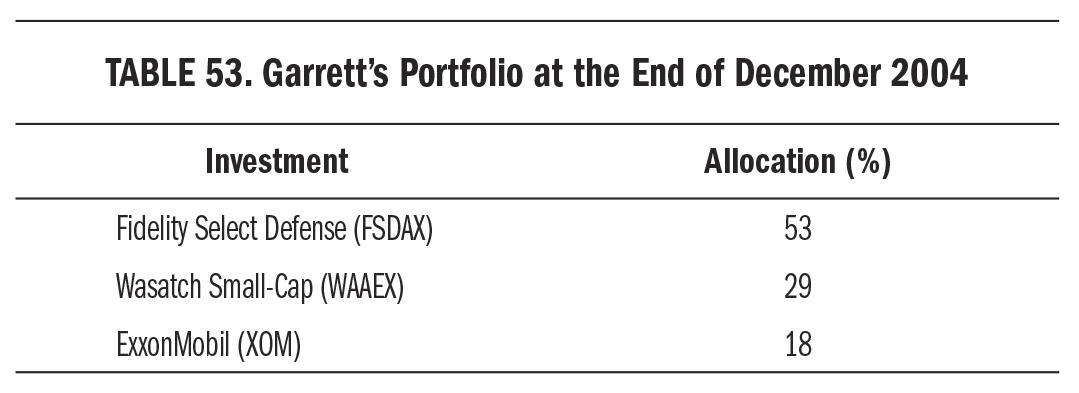
Visit (http://bit.ly/15mwkU2) for a larger version of this table.
Selma was surprised to find herself wondering if her all-star portfolio wasn’t as great as she’d thought. Mark didn’t do much more than she did, and used only two dirt-cheap index funds in the signal system he was always citing as an excuse to avoid stock talk. Whenever Garrett or another colleague started repeating forecasts they’d heard on TV or read somewhere, Mark would hold up a hand and say, “I have no opinion and couldn’t care less. I just follow the signal.” For a while it had been impressive enough that his signal stayed slightly ahead of her all-star portfolio. Now it was no longer just slightly ahead; it was 20 percent ahead. She read more about her funds in the investment media to see if she’d gone wrong somewhere. It didn’t look like it. Consensus expected ever better results from the likes of Mason Hawkins and Bill Gross, so she decided that, for the time being, she’d keep on keeping on. For the first time, however, she did so with a twinge of doubt.
As for Mark, he couldn’t have been happier. His bond balance hit 25 percent that quarter, and he wondered if he’d soon need to move extra bond money into stocks again. When the only challenge he had to contend with was shifting an abundance of bond balance into a surging stock balance, life was good. How much time did he spend listening to z-vals and others paid to make noise for a living? Zero—and he was beating them all.
September 2005
On August 29, 2005, Hurricane Katrina struck Louisiana, causing severe damage to that state and the Gulf Coast from Florida to Texas. The levee system in New Orleans failed, allowing the flooding of 80 percent of the city and prompting a lawsuit against the U.S. Army Corps of Engineers for its role in one of America’s worst civil engineering disasters. The storm killed more than 1,800 people and caused more than $100 billion in damage, making it the costliest hurricane in U.S. history.
Chris Isidore at CNNMoney warned on September 6 that “higher gasoline prices aren’t the only economic fallout from the devastating storm. Real estate and home construction, trade, agriculture and livestock—even the purchasing power of the dollar—are all likely to be impacted by the storm in the coming months.” Worse, it seemed a recession was in the cards:
The prospect that the U.S. economy will significantly slow is one reason many investors and analysts now believe the Federal Reserve may not raise rates at its Sept. 20 meeting, which would be the first time since May 2004 it left rates unchanged.
But there are growing concerns that the combination of higher energy prices and some transportation disruptions, coupled with lower economic activity in the Gulf region itself, could be enough to plunge the economy into an actual recession. . . .
“I don’t think it’s too soon to talk about a recession, even if I still think there’s less than a 50-50 chance,” said Doug Porter, deputy chief economist of BMO Nesbitt Burns. “Every other recent recession has been preceded by an energy shock. Certainly at the least there is a risk that growth will be curtailed.”
Garrett smiled. Energy shock? No problem. He owned ExxonMobil, which had risen smartly along with oil prices. Since he bought it at the end of December, the stock had gained 24 percent and paid $0.85 in dividends per share. It now comprised 21 percent of his portfolio, even though his other two holdings were up a lot, too.
Selma and Mark were also doing well. None of the three investors saw any cause for concern in his or her 401(k), but just to be sure, both Garrett and Selma asked Mark about the current signal. “A very tiny sell,” he reported; “less than ten dollars. It’s saying to stay put.” That’s what they all did.
December 2006
At the end of their sixth calendar year at SnapSheet, these were the retirement account balances of our three investors:
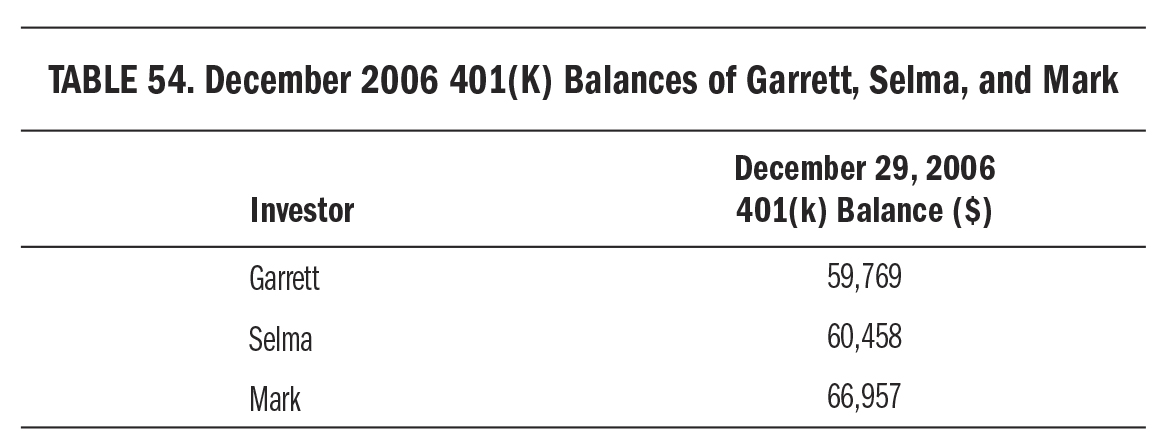
Visit (http://bit.ly/1ySXSeB) for a larger version of this table.
This came as a shock to Garrett, still in last place even after watching his account balance grow 36 percent that year, from $43,805 to $59,769. Select Defense rose 11 percent and paid a whopping $6.61 in dividends for an 8 percent yield. Wasatch Small-Cap was up only slightly but paid $2.92 in dividends. ExxonMobil rose 36 percent and paid a $0.32 dividend every quarter. It was nothing but up, up, and up, yet he hadn’t kept pace with his do-nothing colleagues. How well had their positions done?
Selma’s Longleaf Partners fund rose 13 percent and paid dividends, her Artisan International fund rose 15 percent, and her other funds did well and paid dividends, too. Mark’s IJR small-cap index rose 14 percent and paid a dividend, while his bond fund was flat but sported a 5 percent dividend yield. These weren’t amazing performances, but somehow Selma had outpaced Garrett, while Mark’s quarterly signals extracted enough extra profit from the performance of his funds to put him even farther ahead.
Just about the time Garrett plotted what he could do to sprint ahead of Selma and possibly overtake Mark, another colleague of theirs, whom we’ll call Peter Perfect, began bragging about his investments. Peter told Garrett, “I’m killing it with First Marblehead. The thing occupies a sweet spot inside a sweet spot, taking advantage of loan securitization but with student loans, not subprime. This credit boom has most people eyeing mortgages, but the really smart money is in student lending. These guys take a basket of student loans, turn it into a tradable security for a huge fee, then sell it off. Almost no risk. It’s brilliant.”
“Has the stock done well?” Garrett asked.
“Well?” Peter said, laughing. “You could say so. I paid thirty-five dollars for it a year ago. It was seventy-five earlier this month, and just split three for two.” He let that sink in, then elbowed Garrett and added in a lower voice, “It even pays a dividend every quarter.”
“All the profit’s probably gone,” Garrett said.
“I doubt it. Fundamentals are rock solid. P/E is only thirteen, profit margin is a fat forty-six percent, revenue growth is seven hundred sixty percent, it has two hundred sixty-five million in the bank and almost no debt, and insiders own a third of the company. At least you know if it goes down, the people running the place are going to go down with it, right?”
“Right. Are you buying more?”
“A lot more.”
Garrett confirmed that Peter got First Marblehead’s fundamentals right. All the research he could find on the stock was positive, except for a few analysts worried about overvaluation after the stock’s recent rise. Business had never been better for the company. It just closed a $1 billion securitization of private student loans originated by several banks under different loan programs structured with the help of First Marblehead. He read in the most recent 10-Q (a quarterly report that the U.S. Securities and Exchange Commission requires public companies to file) that Marblehead was shielded from lending risk because it did “not take a direct ownership interest in the loans our clients generate, nor do we serve as a lender or guarantor with respect to any loan programs that we facilitate.” It made money only from “the volume of loans for which we provide outsourcing services from loan origination through securitization.” This seemed promising, what with the cost of college rising exorbitantly, all but guaranteeing demand. Marblehead looked like the ultimate middleman between borrower and lender, making mega profits with minimal risk.
At the end of December 2006, Garrett moved half his Wasatch Small-Cap allocation into First Marblehead stock. Wasatch was his laggard; ExxonMobil, his leader. Maybe another smart stock pick could become a leader, too. Prospects for Marblehead looked even better than those for ExxonMobil, and Garrett thought he might just lead the 401(k) pack with this addition. His new portfolio became:
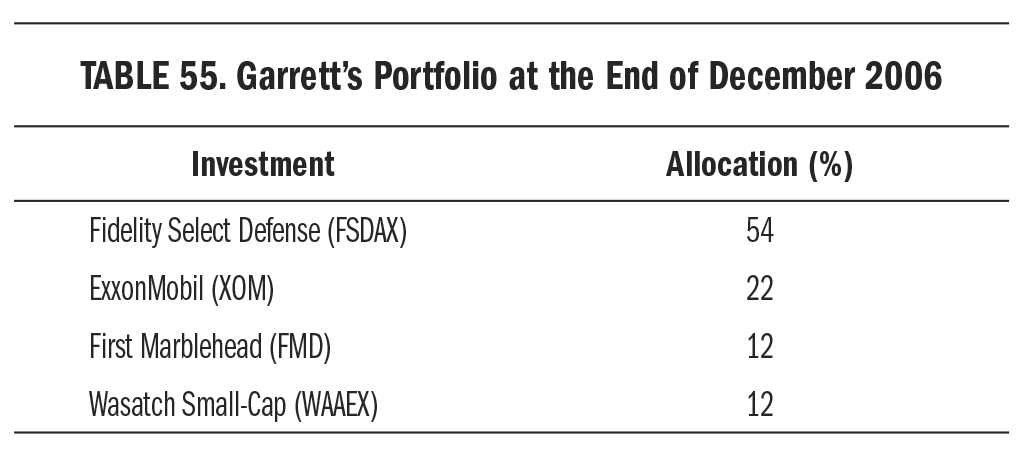
Visit (http://bit.ly/15xHu92) for a larger version of this table.
As for Selma and Mark, they were both pleased with the progress of their portfolios in the bull market, and Mark was surprised to find himself cruising comfortably ahead of Selma. He knew that in a long enough bull market he could fall behind an unwavering, fully invested portfolio, but was reminded by Selma’s position in second place that the full investment needed to focus on high-performing stocks, such as his small caps in IJR. Selma was proving to be nothing if not steadfast, and she had certainly done her homework in selecting the best of the best funds, but she had diversified beyond high-performing categories. Would her team of pros prove their worth in the quarters ahead?
September 2007
News about the troubled housing market was everywhere. A Barron’s article titled “Getting Ready for the Roof to Fall” looked at the strategy of bond fund manager Jeffrey Gundlach, the chief investment officer of TCW Group: “He sees U.S. home prices dropping an average of 12 percent to 15 percent annually from the highs achieved last year and not reaching their eventual trough until late 2008, at the earliest. And they may not start recovering until 2010 or 2011, inflicting, in the meantime, real damage on the economy.”
Gundlach thought the downward trend in mortgage delinquencies and foreclosures would accelerate. “That’s because next year and early 2009 will see a crescendo in the troubled 2006 and early-2007 subprime mortgage vintages reaching their two-year rate reset points, when the low teaser rates expire. Facing jumps in monthly payments of 30 percent or more, many homeowners are likely to just throw in the towel and default on their mortgages.”
Maybe, Garrett thought, but it sure looked like the Federal Reserve was ahead of the curve in supporting the economy. It cut the federal funds rate by 0.5 percent, to 4.75 percent, on September 18, which sent stocks up sharply. He’d read an article in Barron’s a month earlier titled “A Contrarian Should Be Bullish on Stocks,” in which investment newsletter watchdog Mark Hulbert wrote that the stock market’s 7 percent drop from early July to early August, “painful as it undeniably has been, is not likely to be the beginning of a major bear market.” Hulbert reasoned that since the average investment newsletter had turned bearish, it was time to do the opposite, because “a contrarian would conclude that the current sentiment picture does not conform to the typical psychological profile of a major market top.” He suggested that investors think of it this way: “The editor of the average market-timing newsletter is more often wrong than right at market turning points. To be bearish right now requires you to bet that this time he will uncharacteristically get it right. Is that really how you want to bet?”
It wasn’t how Garrett wanted to bet, so he stayed put. From the end of July to the end of September, his account grew 11 percent, to $74,092 from $66,756. That was with a little help from the Fed, true, but wasn’t that legitimate? The Fed always has the market’s back. It’s one of the long-term reasons to stay bullish, he figured. Following the half-point rate cut, USA Today reported, “The Dow soared 335.97, or 2.51 percent, to 13,739.39. The last time it rose more than 300 points in one session was Oct. 15, 2002, when it gained 378 points, and Tuesday’s percent increase was the biggest since April 2, 2003. The blue-chip index is now only about 1.9 percent below its record close of 14,000.41, reached in mid-July.”
Garrett’s First Marblehead bet had gone south, down 31 percent since he bought it the previous December, but it had shot 15 percent higher since July and had grown its dividend from 15 cents in March to 27.5 cents in September. It was still recommended by the Motley Fool Hidden Gems newsletter, and nineteen hundred out of two thousand investors in the Motley Fool CAPS research community thought First Marblehead would beat the market. The company announced earlier that month that its most recent sale of asset-backed securities would raise almost $3 billion. Everything was on track for a good recovery, and Garrett felt fine putting more money into the stock at lower prices. He allocated 12.5 percent of every monthly contribution to it, and would continue doing so.
Besides, his other picks were more than making up for Marblehead’s struggles. Year-to-date, Select Defense gained 18 percent; ExxonMobil, 21 percent; and Wasatch Small-Cap, 9 percent. Once the market caught on to Marblehead’s outstanding business results and reinvigorated the stock, his portfolio would fire on all cylinders and he’d mount some serious profits.
December 2007
At the end of their seventh calendar year at SnapSheet, the 401(k) balances of our three investors stood as follows:
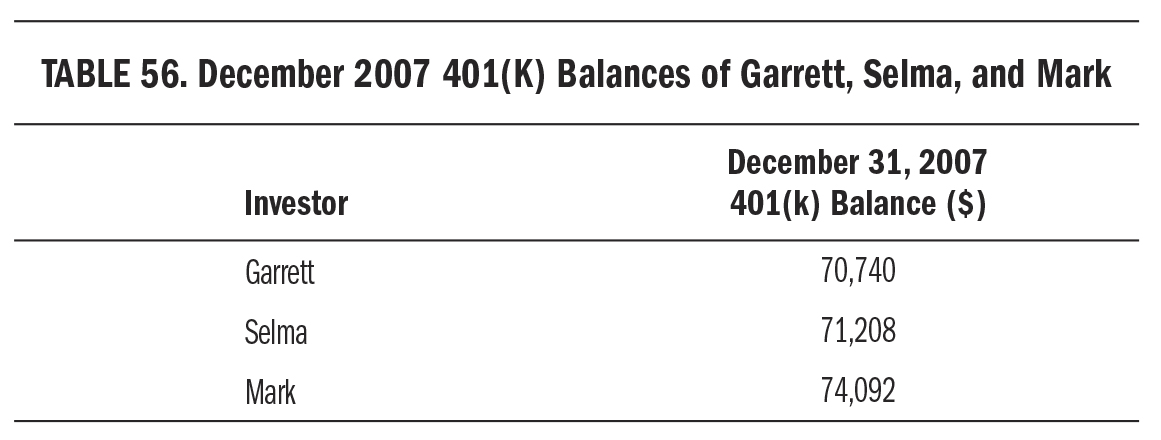
Visit (http://bit.ly/1AZRJLI) for a larger version of this table.
Both Garrett and Selma had narrowed the gap between their balances and Mark’s. Selma’s all-star portfolio seemed to be proving that high expense ratios were worth it, and that careful research of active management track records and sticking with a plan were the keys to profiting over the long term. She was still ahead of Garrett and looked destined to surpass Mark, with no effort.
Garrett wasn’t as upset as he had been at the ends of other years, now that all his hard work had finally paid off. He’d basically kept pace with Selma’s famous fund managers and was closing in on Mark’s smug signal, and that was after First Marblehead nearly gave up the ghost in the fourth quarter, crashing 60 percent. He wasn’t sure what was going on there, given that the company had nothing to do with poisonous subprime lending. All the Marblehead bulls kept insisting that the market was throwing out the baby with the bathwater and suggested averaging into lower prices for an eventual recovery, so Garrett kept his plan going. There wasn’t much risk left anyway, because Marblehead had dwindled to just 3 percent of his portfolio. Even if it blinked out entirely, it wouldn’t matter a whole lot.
Everybody felt fantastic that holiday season, as most investors do at the tail end of bull markets. Mark rarely thought about stocks, but with everybody around him bragging about their bang-up performances, it was hard to ignore them. Garrett had become especially noisy, chiding Mark for ending the quarter with a fifth of his capital in bonds. “I’m still ahead of you,” Mark said, to which Garrett replied, “Not by much anymore.” He never missed a chance to remind Mark that stocks mostly go up. If anybody ever mentioned the dot-com collapse, Garrett retorted, “And what came after it? A raging bull. Money needs to be put to work.”
The signal had been telling Mark to buy most of the year, including that quarter. The only sale was in the second quarter, and it was a modest one. He noticed that IJR had been steadily moving lower since then, to the tune of –9 percent since the end of the second quarter. The next two quarters of buying lowered his bond balance from 27 percent of the portfolio to 20 percent, where it stood after the fourth-quarter buy. At least the signal was moving more of his bond allocation into stocks, the asset class everybody loved talking about. Something was odd, though. If stocks were so great, why had IJR been falling for six months?
He mentioned his thinking about the signal to his wife, one of the rare times he let stock talk invade their home. They agreed that growing the account to $74,000 in seven years without paying any attention to all the fuss on Wall Street was pretty darned good, and better than most. They decided to leave 3Sig to its own devices.
Garrett asked Mark what the signal was saying at the end of December 2007. “To buy,” Mark answered. “A fair amount, too: sixty-four hundred dollars.”
Garrett clapped him on the shoulder. “It’s good to see that signal trying to stay ahead. Most of my newsletters are bullish, too, so your signal is probably right.”
“It’s been mostly right so far. What are your newsletters saying?”
“That we’re going to make more money. I’ll e-mail you some highlights later.” Garrett’s note arrived full of bullish commentary from pundits, interspersed with his own analysis emphasizing quotes and tossing in phrases showing he’d been onto the bull market from the start: “as I expected” and “which was obvious” and “as anybody paying attention could see” peppered the connecting material.
Bob Brinker wrote in the early December issue of his Marketimer newsletter that the stock market’s recent sell-off was good news. “The short-term correction that began in October and continued into November has served as a health-restoring pullback, and has paved the way for new record highs in the S&P 500 index in our view.” Garrett agreed because anybody paying attention to history could see that the market never rose in a straight line. It needed to take a break from rising to avoid getting overbought, he explained.
In the December 6 issue of The Chartist Mutual Fund Letter, editor Dan Sullivan wrote, “What we find remarkable and most encouraging is the fact that the market has been able to make upside progress in the face of extremely adverse news. If history is any guide, this bull market has further to run. We say this because at bull market peaks, the news is highly favorable and the public is jumping in with both feet. Currently, the public is apprehensive with the financial press painting a very bleak picture. This is more indicative of a market bottom than a top.” He kept the letter’s portfolio fully invested.
Garrett added his two cents: “Sullivan is right. Retail investors are too negative here. The time to get out will be when they’re all bullish. There’s more upside ahead in 2008.” He liked what an investor friend of his observed on this score: “We may be at the beginning of the end of this bull run, but not the end of the end.”
Stephen Savage at the No-Load Fund Analyst stayed fully invested, too, because “our valuation work continues to suggest that large-cap U.S. stocks are at least reasonably valued under a broad range of likely growth scenarios. We continue to expect stocks to outperform bonds over our five-year tactical time horizon.” Garrett said his analysis also indicated that stocks were not yet overvalued. “Besides,” he added, “valuation almost never causes a crash.”
Even the Value Line Investment Survey thought stocks could rally in 2008 if “the economy steadies itself and corporate earnings press forward even modestly.” It kept its recommended stock allocation at 75 percent, where it had been since June. Garrett said the odds of profits being “considerably better than modest” were very good. “Don’t fight the Fed,” he advised, “especially when it’s working overtime to keep stocks rising.”
Then came 2008.
Years 8–9
In 2008 and 2009, SnapSheet froze salary increases to shore up its finances in the credit crunch. All three of our investors kept their $72,365 annual salaries of 2007, with monthly contributions of $543 into their 401(k) accounts and $241 into their savings accounts.
The year saw Bear Stearns go bankrupt in March. On Friday, March 14, 2008, its stock fell 47 percent in the first half hour of trading, in a furious exchange of more than a million shares per minute. In New York magazine, Jim Cramer wrote an article after the crash titled, “The Bear Stearns Bull,” and subtitled, “With the collapse of the country’s fifth-largest bank, the market hit bottom.” He didn’t just mean Bear stock itself, either, but “the whole stock market” and “the long-suffering housing market, too.” People like Garrett who followed such advice by either buying into stocks or staying put that March, suffered for the rest of the year. Select Defense, for instance, slipped another 36 percent from the end of March to the end of December.
More than bearish calls ignored, it was the amassing of such bullish calls gone wrong that wore down the resilience of steadfast investors. The feeling of “I should never have listened” destroys more confidence than “I wish I had listened.” For so long, every new dollar invested had withered away, and the bear market wasn’t just dragging out; it was accelerating.
That autumn, Lehman Brothers disintegrated into the wreckage of subprime mortgage–backed securities. Its stock dropped in sickening cascades that would have been newsworthy as one-off events, but they came in series, dragging the market down as the world questioned how large a shock modern finance could withstand. Shares of Lehman dropped 45 percent on Tuesday, September 9, and another 40 percent two days later before the company tried finagling a government bailout over the weekend. When that looked impossible, it desperately sought a suitor. It failed on both fronts, and declared bankruptcy in the early hours of Monday, September 15, in New York.
That day, the Dow Jones Industrial Average shed 504 points in a phalanx of face-whitening financial news. Beside the Lehman saga, Bank of America was forced to buy Merrill Lynch for $50 billion to prevent further unraveling of the financial system when too many of Merrill’s trading partners lost confidence in its solvency, and harsh whispers hinted that the insurance giant American International Group was about to collapse. An AIG collapse, the rumors assured everybody, would make Lehman’s demise look like a child tripping on a grassy field. The credit market upheaval was so severe that the Federal Reserve needed to inject $50 billion into the banking system just to keep overnight rates close to its 2 percent target. Few moments in financial history have produced as much mayhem as the autumn of 2008.
In the first seven trading days of October, the market fell another 22 percent. It recovered a bit by the end of the month, but in the twelve trading sessions from Election Day on November 4 to November 20, it fell another 25 percent. Every familiar metric used to measure stocks became useless. They traded as a block, without regard for specific company fundamentals, and prices across the board drained away. It became a game of pick-a-price on Wall Street, and many people characterized stock investing as just a glorified form of gambling. Rolling the dice for recreation might be fine, but few people wanted to roll the dice for retirement.
At the end of their eighth calendar year at SnapSheet, the 401(k) balances of our three investors had diminished dramatically from the previous year, as follows:
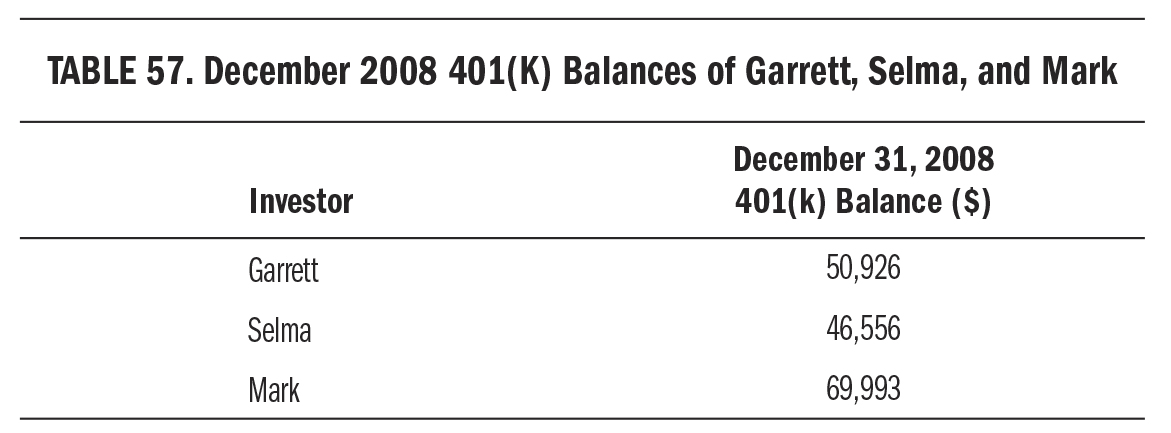
Visit (http://bit.ly/1CvlxV8) for a larger version of this table.
The $69,993 was Mark’s balance after he responded to the largest buy signal his plan had ever issued, which sparked a soul-searching conference between him and his wife. Their balance before the buy signal was $59,117. The issue they faced before deciding to buy was whether it was worth the risk of tapping their savings account to satisfy the signal’s call to throw even more money into the bear market’s maw.
The plan issued buy signals in every quarter of 2008 as IJR fell 32 percent, from $65.02 in the fourth quarter of 2007 to $43.97 in the fourth quarter of 2008, as follows:
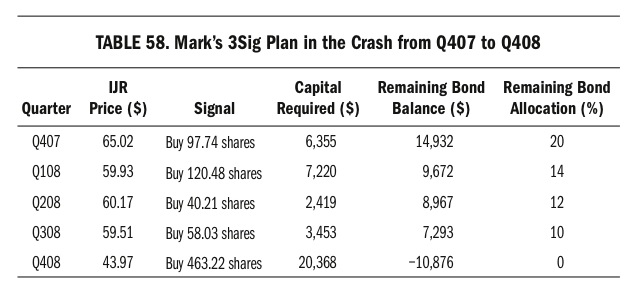
Visit (http://bit.ly/1CKFkgS) for a larger version of this table.
Mark’s $7,293 bond balance at the end of Q308 grew to $9,492 at the end of Q408 with the addition of his $1,629 quarterly cash contribution, a 3 percent rise in the price of his Vanguard GNMA fund, and the total of 12.6 cents Vanguard GNMA paid in monthly dividends that quarter. The buy signal at the end of the quarter required $20,368 in capital, however, which was $10,876 more than his $9,492 bond balance. This was the first time he’d faced the decision of whether to use his bottom-buying capital in the savings account he’d started at SnapSheet’s credit union back in January 2003 with 4 percent of his gross monthly income. Its balance that December stood at $16,044, enough to cover 3Sig’s shortfall, but was doing so a good idea? This is what Mark and his wife discussed in their conference, during which they decided that, yes, it was worth it.
Meanwhile, Garrett’s head spun. He wondered how he could have stayed put through the year. He paged back through the bullish commentary saying to buy the cheaper prices, which helped explain some of his persistence. Then there were reactive bounces along the way, such as Select Defense’s 8 percent rise over the summer, and ExxonMobile’s 8 percent rise in November, and even First Marblehead’s 64 percent rise in August—64 percent! Too bad they were all reactive twitches higher in a dominant downtrend. For the year, First Marblehead lost 92 percent; Select Defense, 44 percent; Wasatch Small-Cap, 42 percent; and ExxonMobil, 15 percent. Marblehead didn’t pay a single dividend during the year, and only ExxonMobil grew its dividend, to $0.40 per quarter from $0.35. Wasatch’s fell to 5.8 cents in December 2008, from $4.59 a year earlier, and Select Defense’s fell to $0.40 from $3.35 a year earlier.
Selma was doing even worse. Longleaf Partners lost 53 percent; Fidelity Growth & Income, 52 percent; Artisan International and T. Rowe Price International, 50 percent; and Oppenheimer Strategic Income, 21 percent. Only PIMCO Total Return avoided trouble, falling just 5 percent.
The final straw for Garrett was something Robert J. Samuelson wrote in The Washington Post on December 8: “Despite the Fed’s frantic efforts to relax credit, it seems to be tightening in the midst of a harsh recession: the opposite of what’s wanted. Private behavior is neutralizing public policy. Lenders are terrified by losses and the fear of what they don’t know; the sudden failure of Lehman Brothers in September compounded their anxieties. . . . The danger is that tight credit and consumer pessimism combine to lower spending, raise joblessness and cause more defaults.” Part of Garrett’s reason for staying in stocks had been his belief that the Fed would hold their prices up. With the central bank looking powerless, he could no longer believe this. If boldly slashing the federal funds rate to 1 percent, from 5.25 percent since September 2007, hadn’t worked, what would?
Garrett read that it was important to stay nimble for the right buying opportunity. After much agonizing, he sold every position in his 401(k) at the end of December 2008 to await better reentry prices. “We’re putting everything in cash and regrouping,” he told his wife, who by then was just plain sick of hearing about the stock market. Holding out in cash had worked for him back in autumn 2002. Maybe it would work again.
Selma couldn’t stand it any longer, either. The only one of her funds that hadn’t let her down was PIMCO Total Return, helmed by the legendary—and now heroic, to her—Bill Gross. As the whole world went to you-know-where in a handbasket, Gross piloted his fund to a mere 5 percent loss for the year and paid twelve monthly dividends for a total of $1 per share in 2008. Even more amazing, the dividend grew from 4.1 cents in January to 53.9 cents in December. Selma remembered the harrowing duration of the dot-com bear market. This new one was so much more severe in the first year—she’d already lost a third of her account—that it would probably wreak havoc even longer. She refused to let another third of her account sink into the subprime sewer. At the end of December 2008, she moved her entire balance into PIMCO Total Return, where she would hide out until the coast was clear. Then, maybe she’d pick through cheap stock funds for another go.
It looked like she’d have plenty of time to go about it. Bill Fleckenstein at MSN Money called the recession one the Fed couldn’t easily fix. Paul Krugman at The New York Times wrote, “The prosperity of a few years ago, such as it was—profits were terrific, wages not so much—depended on a huge bubble in housing, which replaced an earlier huge bubble in stocks. And since the housing bubble isn’t coming back, the spending that sustained the economy in the pre-crisis years isn’t coming back either.” In The Wall Street Journal, Holman Jenkins rued policies getting “twisted and rendered incoherent” in the mounting bank bailouts and auto bailouts, and predicted that “the bad policy vicious circle probably has a long way to run. . . . Bottom line: Politics is in charge—in a way that makes a lost decade of subpar prosperity more likely than not.”
It was against this backdrop of capitulation and despair that Mark and his wife discussed whether to heed their 3 percent signal plan’s largest buy signal yet. What if the economy kept shrinking and SnapSheet reduced its headcount? If Mark lost his job, the family might need the $16,044 they’d saved at the credit union. “We have some other savings,” Mark said. “We own our cars outright. I haven’t heard any bad news at work.”
“So, you think we should use the savings,” his wife said.
“Yes. Moments like this are exactly when the plan works, and they don’t happen often. Buying now is scary, but that’s why we follow the signal, so we can get our bearings. We’re supposed to do what it says. Needing to use our bottom-buying money to do what it says this time means it’s probably a very important buy signal. The eleven grand we put into IJR here could become fifteen grand in a couple of years.”
“Or six grand, with you out of a job.”
“Or six grand,” he repeated. “I know. Anything could happen. I just think the signal has steered us basically right so far, and it’s backed by market history. It’ll probably be right this time, too.”
They sat quietly for a few minutes. Then his wife breathed in deeply, squeezed her husband’s hand, and said, “Okay, let’s buy it.” Mark moved the $10,876 into their 401(k) and fully funded the biggest buy signal the plan had ever issued. Then he threw up.
March 2009
The market kept dropping. Mark and his wife’s $11,000 became $9,000 as IJR lost another 17 percent. Their account balance fell to $59,753, and the plan issued a second giant buy signal, this one for $13,154 more than the meager $1,826 they had in Vanguard GNMA. They could have used the $5,891 in their savings account to get closer to the full buy signal, but both agreed that enough was enough. Mark used only the $1,826 in Vanguard GNMA, and even buying that much more of the stock market felt foolish.
He was amused to see a note he’d written in December reminding himself to ignore the next four sell signals. On a quarterly closing basis, SPY had peaked in the third quarter of 2007, at $152.58, setting the 30 percent threshold for the plan’s “30 down, stick around” rule at $106.81. When SPY closed the fourth quarter of 2008 below it, at $90.24, it triggered the stick-around mode of skipping the next four sell signals. How quaint this looked to Mark now. A sell signal would require a rising stock market. When was the last time he’d seen one of those? In his present situation, without buying capital, he would have to ignore every signal, not just sell signals.
Garrett’s all-cash account grew to $52,555 from $50,926 at the end of December, due to his monthly contributions alone. Just seeing something positive while stocks crashed filled him with relief. Guess who had not lost 17 percent that quarter in Select Defense? Garrett, that’s who. A painless three months! He assumed his plan was working. He’d be able to buy at cheaper prices later.
Selma felt even better. That Bill Gross at PIMCO was some kind of genius, all right. Since she put her entire $46,556 account balance in PIMCO Total Return at the end of December, it had grown to $48,861 thanks to her monthly contributions, a stable price, and a total of 15.3 cents per share paid in three monthly dividends. Everything she’d sold, by contrast, kept falling apart in the first quarter: Fidelity Growth & Income was –12 percent; Artisan International, –10 percent; T. Rowe Price International, –9 percent; Oppenheimer Strategic Income, –6 percent; and Longleaf Partners, –2 percent. “Good riddance to them,” she thought. She had a good thing going at PIMCO, higher returns without the worry. She was even starting to wonder about ever buying back into stock funds. The very thought of it made her queasy.
John Plender captured the reasons in his March 2, 2009, article in the Financial Times, which began, “As stock markets everywhere continue their slide, global equities have in effect now shed all of the gains they had notched up between the Asian economic crisis of 1997–98 and the onset of the credit crisis in 2007.” He continued:
The message of all this misery is summed up by Michael Lewitt of Harch Capital Management, a fund manager who was quick to identify the risks in the credit bubble. “Virtually every strategy institutional investors followed, or were advised to follow by their consultants or funds of funds,” he says, “turned out to be a complete disaster.” . . .
[D]iversification cannot work well in a credit bubble because virtually all asset categories are driven up by leverage. Then when the bubble bursts, deleveraging affects asset categories indiscriminately. Equally fundamental is that fund managers tend to move in herds because that reduces the risk of their losing client mandates. Minimizing business risk takes priority over the interests of beneficiaries.
In a March 5 article in Forbes, “The U.S. Financial System Is Effectively Insolvent,” Nouriel Roubini wrote about the “rising risk of a global L-shaped depression that would be even worse than the current, painful U-shaped global recession.” The reasons were obvious:
The scale and speed of synchronized global economic contraction is really unprecedented (at least since the Great Depression), with a free fall of GDP, income, consumption, industrial production, employment, exports, imports, residential investment and, more ominously, capital expenditures around the world. . . . With stock prices down over 50 percent from peak and home prices down 25 percent from peak (and still to fall another 20 percent), the destruction of household net worth has become dramatic.
He preempted any improvement in stock prices by labeling it a head fake: “Of course, you cannot rule out another bear market suckers’ rally in 2009, most likely in the second or third quarters. The drivers of this rally will be the improvement in second derivatives of economic growth and activity in the U.S. and China that the policy stimulus will provide on a temporary basis. But after the effects of a tax cut fizzle out in late summer, and after the shovel-ready infrastructure projects are done, the policy stimulus will slacken by the fourth quarter. . . .”
Thus was the mood in March 2009. Not only were markets down, but they were going to stay down for a long time. Even if they perked up, it would only be temporary, before they moved lower again. Whatever you do, went conventional wisdom, don’t bet on stocks. Garrett certainly wouldn’t; nor would Selma. Mark wished he hadn’t, but he did his best to tune out until the next quarter. If there was indeed a suckers’ rally, he’d just have to be one of the suckers.
A funny thing happened on the way to oblivion. Stock prices rose—a lot. It was a suckers’ rally, no doubt, as Garrett and z-vals and incarnations of Peter Perfect were quick to point out. Anybody buying it or owning it had only happened upon profits by blind luck—everybody could see that—and they were just playing with fire ahead of the next waterfall plunge. Hadn’t Roubini and others foreseen this very knee-jerk move higher and pre-labeled it for the benefit of the smart money?
You bet they had, which was why Mark had a hard time following 3Sig’s “30 down, stick around” rule. The plan followed the two largest buy signals it had issued since Mark began it, the ones of Q408 and Q109, with the two largest sell signals it had issued, in Q209 and Q309. They told him to sell $10,595 of IJR at the end of June 2009 after the fund had gained 22 percent in the second quarter, then to sell $9,985 of it at the end of September 2009, after the fund had gained 18 percent in the third quarter. He joked with his wife, “Suckers’ rallies are fun!” They contemplated whether to just follow the signal and take some profits in case the market did head south again, as the z-vals were warning would happen, but they decided it was too late to start second-guessing 3Sig now.
Garrett said Mark was an idiot to keep everything in stocks. “And small caps, no less,” he added.
In June, he told Mark that famous short-seller Doug Kass, who almost perfectly timed the 40 percent rise from March by switching from a bearish view to a bullish one that month, suddenly saw potholes ahead. Kass thought investors were too optimistic. “The same talking heads who were scared witless in March have turned back into perma-bulls,” Kass said in a Barron’s article that month, in which he also suggested it was going to become a “square-root sign shaped rally,” a plunge followed by a spike followed by a long, flat, go-nowhere market. The article ended on the idea that Kass “says most people like to rationalize reasons to buy stocks when prices are going up. Now Kass is looking toward doing the opposite of the crowd—just as when he was buying ahead of the March lows.”
“Fine,” Mark shot back at Garrett in a rare display of emotion regarding stocks. “Guess who else said to buy stocks in March? I did, after looking at 3Sig. I just didn’t have enough money to follow it all the way. I bought in December, though, and as much as my account could afford in March, and I’m glad I did. The plan says to stay put, so that’s what I’m going to do.”
In September, with Garrett still in cash and Selma still entirely in PIMCO Total Return, Mark dutifully ignored the second-biggest sell signal his plan had ever issued, thereby wrapping up four straight quarters of the biggest moves he’d witnessed to date, two drops and two rises.
“Are you really staying in small caps?” Garrett asked. “Really?” He e-mailed a link to a September 17, 2009, MarketWatch story by David Callaway, “As Dow 10,000 Looms, a Time to Worry,” which intoned, “In March, it was just a relief that stocks rose after six months straight down. In April and May, it was perplexing. In June, July and August, it was invigorating as the market recouped 50 percent of its losses. Now, in September, supposedly a bad month for stocks, it’s getting scary.” He believed “a correction is inevitable” and worried about bad earnings, Washington gridlock on health care and financial regulation, bank failures, and unemployment approaching 10 percent. When the correction finally arrived, he predicted it would “come with a loud crack in equities, as all the positive momentum behind the market right now suddenly shifts to an embarrassing, emperor-without-clothes type of feeling, which will precede a rush to sell.”
Mark wrote back to Garrett: “If the correction does come, my signal will say to buy it . . . and I will.” It didn’t happen, in the fourth quarter, when IJR gained another 5 percent and the plan issued its third sell signal in a row. It was a small one, just $515, but it was a sell signal nonetheless, and Mark ignored it as he was supposed to do during the stick-around phase. There was just one more to go.
With Garrett in cash, Selma in PIMCO Total Return, and Mark sitting on a 94 percent allocation to IJR with only 6 percent in bonds, here’s how the 401(k) balances of our three investors finished their ninth calendar year at SnapSheet:
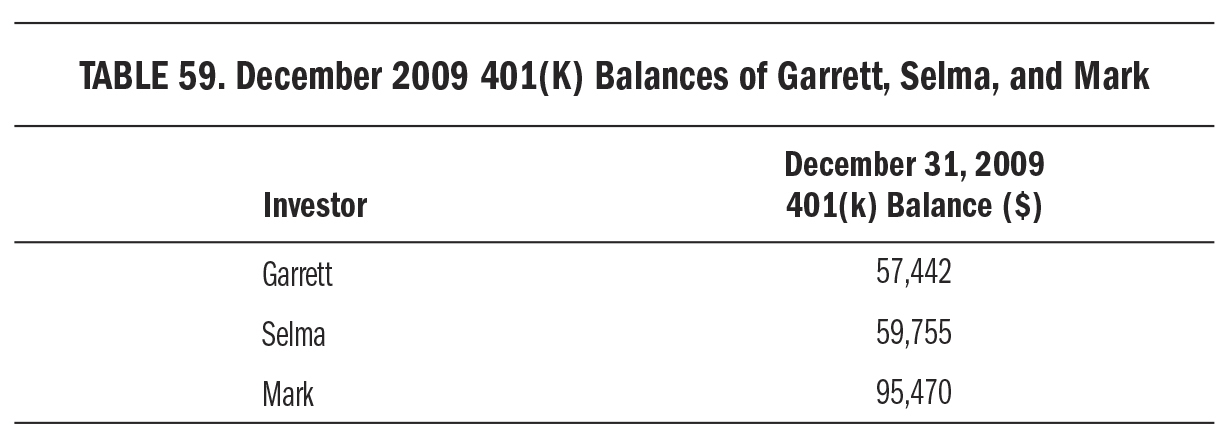
Visit (http://bit.ly/1yDBk2D) for a larger version of this table.
Bloomberg news columnist Caroline Baum selected new normal as the most overused term of 2009. It reentered the lexicon in May, when PIMCO, home of Selma’s favorite investor, Bill Gross, forecasted a new normal of slower growth, higher regulation, and a diminished role for the United States in the global economy. Soon thereafter, everybody began calling everything the new normal, and Baum thought “overuse has rendered new normal meaningless.”
Maybe, but the idea that something had permanently changed for the worse pervaded people’s thinking. Richard Rahn, chairman of the Institute for Global Economic Growth, wrote in The Washington Times at year-end: “The long-term outlook for the stock market is not good, and here is why. For the past 100 years, there has been an inverse relationship between changes in the size of government and the growth or decline in the stock market.” Because the U.S. government’s share of GDP had gone from 21 percent to 28 percent in eighteen months, Rahn was pessimistic.
Years 10–13
In 2010, SnapSheet resumed salary increases after freezing them in 2008 and 2009, but did so gradually with only a 2 percent raise that year. In the three years following, it provided 3 percent annual increases, which was typical across the nation back then. Here’s how these modest advancements trickled through the income and savings picture of our three investors:
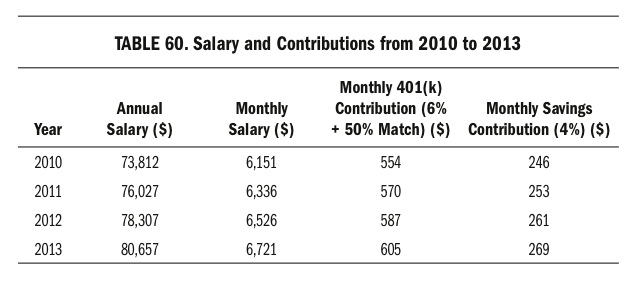
Visit (http://bit.ly/1L53k4s) for a larger version of this table.
June 2010
After ignoring the fourth and final sell signal in the stick-around phase of his plan, which happened in the first quarter, Mark found himself in June 2010 face-to-face with another buy signal demanding more than his bond balance could handle. The 3Sig plan said to buy $12,479 worth of IJR, but he had only $9,495 in Vanguard GNMA. Should he make up the $2,984 shortfall with his bottom-buying account?
The decision was a lot easier this time than last time, for a couple of reasons. First, it was obvious that the only reason he didn’t have enough in bonds was that he’d ignored four sell signals in a row. Three of the four had been good calls, as the stock market kept rising and had pushed the value of the money he kept invested in it even higher. He’d have had more than enough in his bond fund to cover the new buy signal if he’d been selling IJR on the way up, but his overall balance would have been much lower. Second, by June 2010 he’d already replenished his savings account up to a balance of $9,536. Seeing his savings balance rise along with his retirement balance created boldness from the wealth effect. He was more willing to throw extra money at stocks in a bad quarter after several good quarters than he had been at the bottom of several bad quarters that made everybody poorer. Besides, he figured this would probably be the last time he’d have to use the bottom-buying account for a while because the stick-around phase was over, so later sales of stock strength would bulk up his bond balance again. His wife agreed, and he used $2,984 from their savings account to fund the buy signal.
Garrett stayed in cash and Selma in PIMCO Total Return, and both were happy, given the prevalent belief that stocks were still trapped in a long-term bear market with occasional bounces along the way. That quarter’s 12 percent drop in the S&P 500 emboldened bears to say, “See? Told you so.”
In a June 11, 2010, article titled, “Why the Worst Isn’t over Yet,” David Rosenberg, chief economist at Gluskin Sheff, told Fortune that stocks were only 60 percent of the way through a secular bear market and that “rallies are to be rented and not owned.” His overall advice? “Be very defensive. I would be 30 percent equities, 50 percent bonds, and 20 percent cash.” On the other hand, he thought gold was “in a secular bull market” and predicted it would reach $3,000 per ounce in the inflationary environment sure to come from the Federal Reserve’s balance sheet expansion from $850 billion in mid-2007 to $2.3 trillion that summer, when gold bounced around $1,200 per ounce. Garrett made note of this idea.
December 2010
At the end of their tenth calendar year at SnapSheet, the 401(k) balances of our three investors had diverged noticeably:
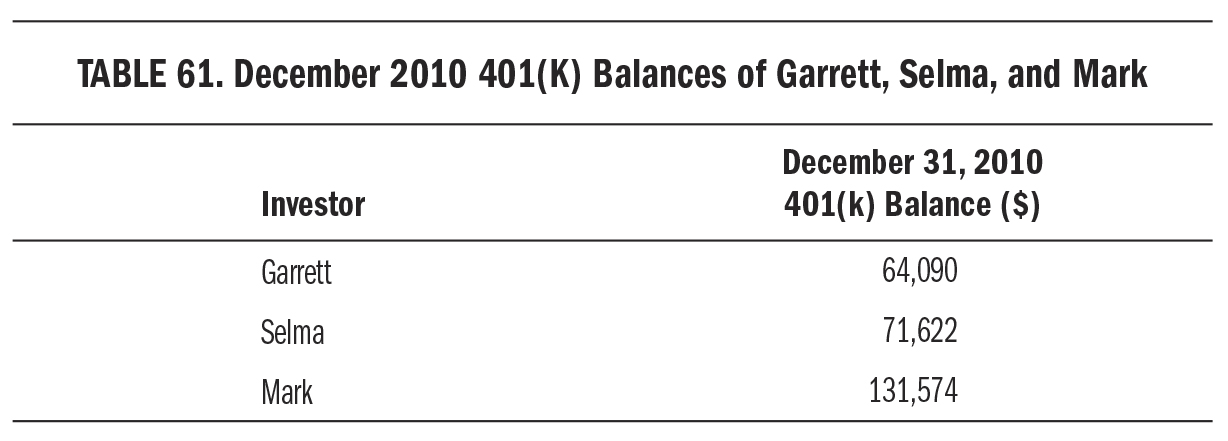
Visit (http://bit.ly/15DYP0J) for a larger version of this table.
This disparity was not lost on Garrett, despite his seeing bearish commentary in every direction: the z-vals were warning of inflation from the Fed’s “dollar-killing policies”; collapse in the euro zone; crushing debt in Japan; the anemic recovery in America, which saw an alarmingly low labor force participation rate; and most of all, the fact that stocks weren’t higher due to fundamental improvement but only because their prices were being propped up by Federal Reserve chairman Ben Bernanke’s easy-money fixation. Couldn’t people see this? It was a false rally. The Fed pumped cash with abandon, creating another bubble that would end badly. Garrett had learned the hard way that what goes up can come down, and things had gone up just a little too quickly in the past two years with no demonstrable improvement in the situation.
Doug Kass reappeared on Garrett’s screen during a free trial of the $999.95-per-year RealMoneyPro service, warning in a December 15, 2010, article titled, “Kass: Color Me More Bearish,” that stocks were “overbought and overloved,” and citing “the rapidity of the rise in interest rates” as one of several reasons to be cautious. Kass lamented that the “country’s leadership has taken the easy route and has demonstrated still further that there will be no meaningful movement on our burgeoning deficit. The bond vigilantes smell blood, recognize this inertia and are demanding a price to be paid in much higher interest rates.” He concluded: “I believe the prudent course shouldn’t be the adoption of too much risk at the current time,” then reiterated his article’s title, “Color me more bearish.”
Garrett had to do something, though. He heard how well Selma had performed with her all-bond portfolio and thought about copying her for a while until he figured out an edge. He didn’t want to be one of the dumb money retail investors who buy higher stock prices just before another rollover, but he couldn’t just stay in zero-interest cash forever.
The problem with bonds, according to his newsletters, was that their best days were probably over. They’d had a great run as investors sought safety, and inexplicably, they had not seen lower interest rates that autumn as the crisis in Europe accelerated and the Fed kicked off another quantitative easing program, dubbed QE2, for $600 billion worth of long-term Treasuries. Bond watchers called the failure of rates to fall in the face of such buying a sea change in the market, one suggesting a bond price top. This had Garrett thinking an all-bond stance wasn’t a prudent choice. He decided he’d put only half his capital into a bond fund.
He settled on DoubleLine Total Return, under lead manager Jeffrey Gundlach and comanager Philip Barach, two of just a handful of bond jockeys who could hold a candle to Bill Gross at PIMCO. Gundlach and Barach did well investing in mortgage-backed securities while running a fund at TCW from 1993 to 2009, and that took skill given the subprime smash-up. Garrett remembered Gundlach predicting in September 2007 that mortgage delinquencies and foreclosures would accelerate, and boy had he been right. After departing TCW in 2009, Gundlach started DoubleLine Total Return in April 2010, and it was already up 16 percent in eight months. The comanagers put half the fund in long-term, government-backed mortgages and the other half in nongovernment-backed, including subprime and Alt-A mortgages, at deep discounts to their original prices. The fund was supposedly well shielded from rising interest rates, with analysts estimating that a 1 percent uptick in rates would push the fund down a mere 3 percent or so. Putting half his capital with Gundlach and Barach, two proven bond market operators, looked smart to Garrett. It would get him back in the market without exposing him too much to the dangers that Kass and others saw in stocks at high prices.
With a quarter of his account, he would finally buy gold. Since summer, he’d begun looking at the best inflation protection known to man, what the great economist John Maynard Keynes called the “barbarous relic.” Garrett read articles online about gold and silver and bought a new book called Hard Money: Taking Gold to a Higher Investment Level, by Shayne McGuire, head of global research at the Teacher Retirement System of Texas and manager of its $500 million GBI Gold Fund, one of the world’s largest pension funds.
McGuire called gold “the best method for shorting the government,” and argued, “Betting against government—that is, on a sudden, sharp rise in inflation—has strong odds in the midst of surging government deficits.” Inflation, even hyperinflation, “can erupt when the public grows wary of the money being printed in growing quantities by monetary authorities, which are forced to buy—to ‘monetize,’ in the financial vernacular—a surging supply of government bonds that the markets no longer all want to buy.” He pointed out that “Gold is the only credible currency whose quantity cannot be expanded at will to meet the spending needs of governments in distress. By its very nature it remains scarce and rises in value as the supply of paper money grows.” Garrett thought gold could provide just the adrenaline shot his account needed. According to McGuire, “Over the past decade, stocks were down 24 percent while gold rose 280 percent, a fact that would have benefited any fund with a significant gold investment. Gold was beating stocks even during the 2002–07 stock-market rally.” This was very convincing, as was the metal’s continued rise after the bear market bottom in March 2009. McGuire wrote, “I strongly believe that present financial conditions are about to transform the investment strategies of the world’s largest investment funds in a way that will cause gold to surge substantially higher.”
After long deliberation, Garrett concluded that he needed to be bold if he was ever going to make up for lost time. His bond allocation was safe enough, so he’d go for it with a quarter of his remaining capital by putting it in gold via SPDR Gold Shares, the most liquid gold ETF. At the end of December 2010, then, his portfolio moved from all cash to this:
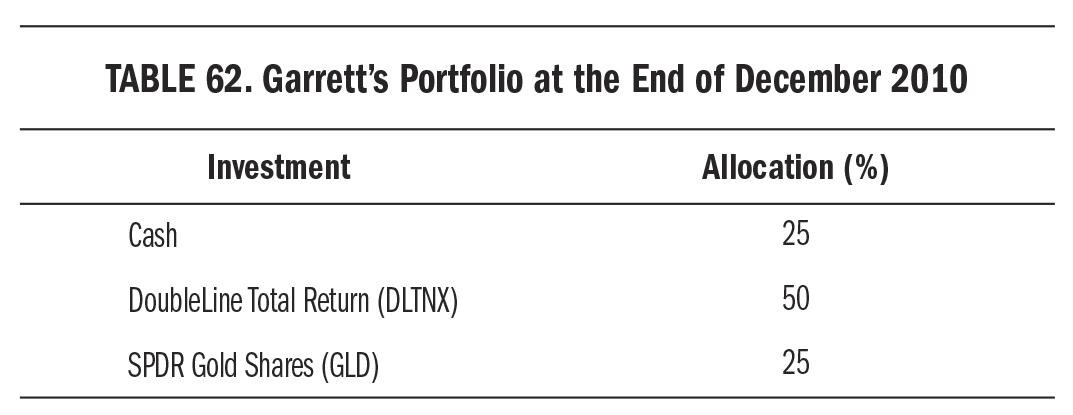
Visit (http://bit.ly/1xKN1k3) for a larger version of this table.
Selma was also ready for a change. The financial planner at her church finally convinced her to move some of her account out of PIMCO Total Return and into stocks. “At your age, you just can’t keep everything in bonds,” the planner said. Selma replied that bonds had been good to her, far better than stocks had been, and that the last thing she wanted to do was go through another crash like the last two. The planner said such crashes were rare, to which Selma replied, “Not in the past decade, they haven’t been.” Nonetheless, she reluctantly agreed to move half her account back into stocks, this time dividing the stock portion evenly between just Artisan International and Longleaf Partners. Artisan had had a rough 2010, but analysts chalked this up to the fund’s deployment of capital in undervalued European stocks, and most thought the short-term underperformance would be rewarded later. Longleaf had regained its stride, beating 90 percent of mutual funds in its large-blend category in 2010, and Morningstar noted “an absence of steep losses among the fund’s larger holdings,” which reassured Selma. At the end of December 2010, her portfolio became:
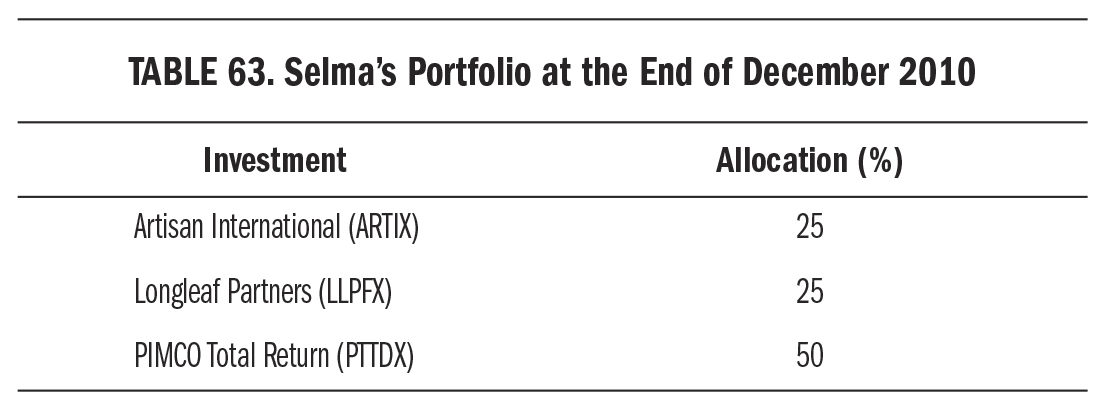
Visit (http://bit.ly/1zDTu61) for a larger version of this table.
Both Garrett and Selma specified for their automatic monthly contributions to be divided along the same allocations they’d set up at the end of December.
As for Mark, he was happily back to his default mode of ignoring markets. He’d exited the stick-around phase of his plan and resumed following the signal as usual after the first quarter. It looked like the hard times he’d experienced when deciding whether to use his bottom-buying account were over. After two big IJR sales in the third and fourth quarters of 2010, for respective amounts of $5,397 and $12,719, his bond allocation returned to a comfortable 17 percent of his account, and he returned to cheerfully disregarding all stock market information beyond quarterly closing prices. Whenever Garrett offered forecasts or warnings from whichever z-val currently topped his research pile, Mark just held up three fingers for 3Sig and said, “Good luck.”
December 2011
At the end of their eleventh calendar year at SnapSheet, the 401(k) balances of our three investors showed Mark to be doing nearly twice as well as his colleagues:
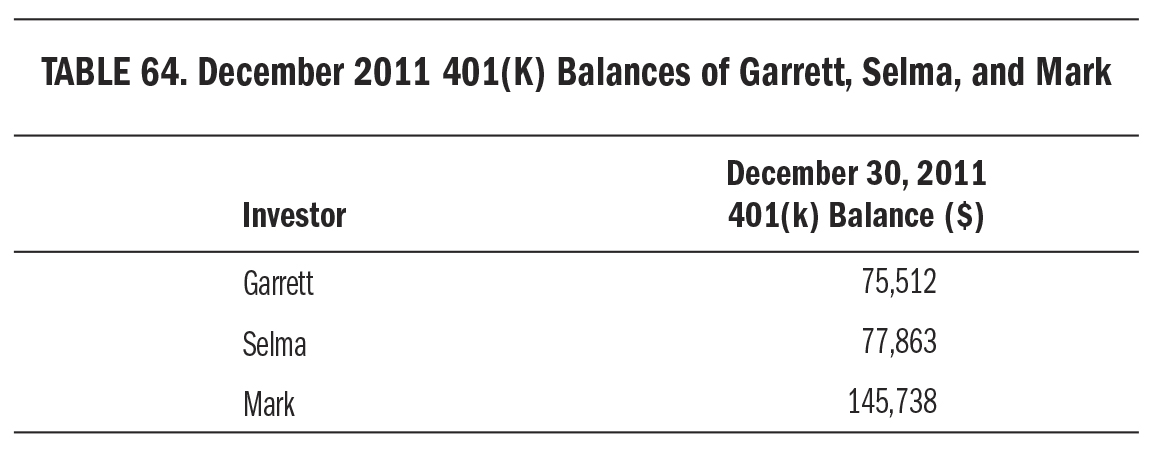
Visit (http://bit.ly/1zDTvH2) for a larger version of this table.
Garrett felt much better, nonetheless. Including his contributions, his double-barreled bond/gold portfolio had grown his balance 18 percent for the year, from $64,090 to $75,512. What’s more, he was pleased to note that his DoubleLine Total Return bond fund had outperformed Selma’s PIMCO Total Return. DoubleLine gained 1 percent in price while paying 88.2 cents per share in monthly dividends for the year. By contrast, PIMCO was flat in price while paying 39.5 cents in dividends. At the end of December 2011, DoubleLine’s yield was 8.0 percent compared with 3.6 percent at PIMCO. Take that, Selma!
More important, Garrett had discovered the joy of bonds. DoubleLine’s price moved little throughout the year as it paid about a 7-cent dividend per share every month no matter what happened in the news. He could see why Selma had moved her whole account to PIMCO in the subprime crisis, and also why her account had kept growing impressively in the quarters that followed. Bonds weren’t bad, not bad at all. That’s not what his newsletters had led him to believe.
Even better, his gold bet had gone swimmingly, up almost 10 percent for the year after an initial drop in January of 6.4 percent that nearly sent him for the exits. He held on to the shares he’d bought the month before, however, and continued buying more shares every month with a quarter of his monthly contribution, and GLD recovered smartly over the course of the year.
There was something gratifying about achieving such big gains without owning a single stock or stock fund. The nonmainstream feel of bonds and gold, and the rare combination of the two that he’d achieved by paying attention to information that most investors ignored, put him in rarefied air, at least in his own mind. “Let the hoi polloi buy stocks,” he told his wife that month after reporting the substantial appreciation in their retirement account. “We’ll stick with bonds and gold.”
Meanwhile, Selma was disheartened by her account faring worse after the reintroduction of stocks than it would have done had she left it entirely in PIMCO Total Return. Artisan International slipped 9 percent in 2011; Longleaf Partners, 6 percent. She calculated what her balance would have been had she not deviated from the 100 percent allocation to PIMCO, and came up with $81,329. After diluting PIMCO down to half her account and dividing the other half between Artisan and Longleaf, she’d ended 2011 at a balance of only $77,863. It wasn’t a big difference, but it did underscore the appeal of handing money over to Bill Gross and the PIMCO posse, who seemed never to slip up.
She mentioned this offhandedly to the financial planner at her church one Sunday that December, and the planner said, “Give it time. Market history proves that diversifying into stocks pays off in the end.” Selma wondered what end, but let it go. She’d stay the course to eventually benefit when Artisan and Longleaf recovered. Recovered. Now there was a word she’d never had to use with PIMCO Total Return. The fund just moved higher, come what may. No wonder Gross was a billionaire, and that people called him the Bond King.
Mark did nothing but follow 3Sig at the end of each quarter. The plan had called for a big buy in the third quarter of the year—$28,095 worth of IJR—but his bond balance of $29,249 had been enough to cover it, so he hadn’t even paused before placing the order. In this current fourth quarter, the very next one following the big buy, his plan signaled a time to take profits. He followed it, selling $15,826 worth of IJR, which put his bond balance at a comfortable 13 percent of his account.
Unbeknownst to Mark, the z-vals had been fretting up a storm in the third quarter of his big buy. They certainly hadn’t recommended buying. The most prevalent worry was that the “failed policies” of President Barack Obama would smother America in national debt, which already tallied $14 trillion while the economy still struggled. In fact, it was worsening again. In a September 15, 2011, article in The Fiscal Times titled, “Economists Double Down on a Double Dip Recession,” Michelle Hirsch reported:
A new series of economic reports out today confirm U.S. economists’ fear that the early signs of a second recession are taking hold. Weekly jobless claims hit a 2-month high indicating employers are pulling back in an already weak labor market. Labor Department figures show jobless benefits applications rose 11,000 to 428,000 last week, pushing the average up for the fourth straight week to 419,500. Economists agree that applications need to dip below 375,000 to signal hiring is picking up enough to cut the nation’s 9.1 percent unemployment rate. “The trend in jobless claims is an important input into our recession probability model, and if this trend were to continue for a number of weeks it would raise a warning flag on the state of the economy,” said John Ryding, chief economist at RDQ Economics.
John B. Judis warned in a September 14, 2011, article in The New Republic titled simply, “Doom!” that the current prolonged recession:
does not merely resemble the Great Depression; it is, to a real extent, a recurrence of it. It has the same unique causes and the same initial trajectory. Both downturns were triggered by a financial crisis coming on top of, and then deepening, a slowdown in industrial production and employment that had begun earlier and that was caused in part by rapid technological innovation. . . . The recessions in 1926 and 2001 were both followed by “jobless recoveries.” . . .
In each case, the financial crisis generated an overhang of consumer and business debt that—along with growing unemployment and underemployment, and the failure of real wages to rise—reduced effective demand to the point where the economy, without extensive government intervention, spun into a downward spiral of joblessness. The accumulation of debt also undermined the use of monetary policy to revive the economy. Even zero-percent interest rates could not induce private investment.
At year’s end, commentators still worried about the weak economic recovery. Gene Epstein mentioned in the December 17, 2011, Barron’s that “The recovery from the 2008–09 recession has been the slowest since any recession in the post–World War II era. It has taken nine calendar quarters since the recession ended in the second quarter of 2009 for real gross domestic product to climb back to its fourth-quarter ’07 peak.”
Neil Irwin recapped the year in a December 31, 2011, article in The Washington Post titled, “After Wild Ride in 2011, Stocks Back Where They Started,” which began, “After all the turbulence of the past year, the solid rallies and breathtaking drops, the U.S. stock market, like any roller coaster, ended back almost precisely where it started.”
Various forecasts piled up as the year wound down. Reasons to freeze in place included a Greek default widely characterized as “inevitable,” the potential global cash crunch that crashing European banks would unleash, a renewed collapse in the U.S. employment market, the falling U.S. savings rate, a dysfunctional government in Washington that would drive America to bankruptcy, and a U.S. debt downgrade that would wreak havoc on financial markets.
Even Garrett wasn’t tuning in as much as he used to. Sometimes the experts were right, sometimes wrong. What was the point in paying attention?
At the end of their twelfth calendar year at SnapSheet, the 401(k) balances of our three investors still differed greatly:
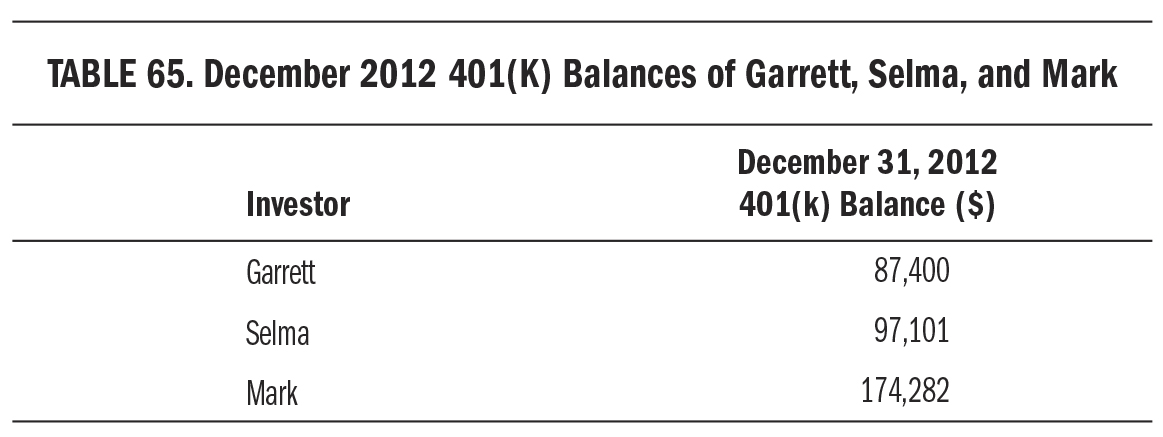
Visit (http://bit.ly/1xKN3Zi) for a larger version of this table.
Garrett was beside himself. He’d begun tuning in to the z-vals again, who argued endlessly about the prospects for gold going forward. No other asset engendered views as far apart as the ones on gold. Half the commentators thought it was worth nothing in the long run because it’s a nonproductive asset valued only because of its scarcity. The other half thought it was worth an infinitely high number because its scarcity made it the only monetary medium that would hold value in a world of endless money printing.
As this debate raged in 2012, Garrett’s GLD position flatlined for the year. The metal had been declining steadily in the fourth quarter, from $1,800 an ounce at the beginning of October 2012 to less than $1,700 at the end of December. Mainstream financial media z-vals couldn’t resist calling it “tarnished,” but two of Garrett’s newsletters remained steadfastly bullish on it, both agreeing with Tocqueville Gold Fund comanager Doug Groh, who told MarketWatch in December, “Monetary policy around the world is prompting investors to seek alternatives to whatever currency they’re in.” Groh said that developed countries were debasing their currencies as emerging markets bought gold, and predicted that “in the next year we’ll see the $2,000 mark and the gold cycle [won’t be] over until we see the $2,400 mark.”
Somehow, Garrett didn’t buy this. “Call it instinct,” he told his wife. “I just think gold has done about all it’s going to do in response to runaway money printing. It’s not like they started pumping money just last week. They’ve been doing it for four years, but there’s no inflation yet. I think that’s why gold is falling and I think it’ll keep falling.”
Beyond that, he decided that all the bears were wrong. They’d been wrong all along. What he should have done was buy leveraged stock funds back in March 2009, when all the idiots said the world was ending. He knew it wasn’t ending. He’d always known. Obviously the news couldn’t have gotten any worse back then after all they’d been through. Why had he waited for cheaper prices? He promised himself he would pay more attention to the bulls from then on, starting by ignoring the bearish concerns about the fiscal cliff Washington was about to tumble over. Everybody was gloomy about Democrats and Republicans being unable to cut a budget deal, which would trigger automatic across-the-board spending cuts and tax increases, which would send the economy into a recession and push unemployment higher.
Here’s what the bulls saw: private-sector growth of 3 percent, improving home prices, a rising stock market, and so much money parked in bonds that any adjustment back into stocks would send the market even higher. Edward Yardeni wrote in the Financial Times on December 10, 2012, “There should be enough growth to boost revenues and earnings for the S&P 500 companies by 5–7 percent. Valuation multiples should rise next year. If so, then the bull market should continue—sooner rather than later if there is a deal to avoid the fiscal cliff. If not, there is likely to be a correction that should provide lots of good buying opportunities.”
A week later, in the Barron’s cover story “Outlook 2013,” Vito J. Racanelli reported, “The 10 strategists recently surveyed by Barron’s see more gains ahead next year. Their mean S&P prediction for 2013—1562—implies a 10 percent price gain from current levels.” The experts, from the likes of Barclays Capital, BlackRock, Goldman Sachs, and Morgan Stanley, agreed that some kind of political deal would mitigate damage from the fiscal cliff.
So, back into stocks, Garrett concluded. He was tired of spinning his wheels and wanted to ratchet up the aggression. One of his newsletters thought the Fidelity Advisor Small Cap fund was set for a bang-up year ahead, and it appealed to Garrett for its potential to beat the small-cap index that had kept Mark dumbly happy for so long. The fund had trailed its category in 2012, but manager Jamie Harmon’s focus on high-quality stocks and broader diversification was expected to reinvigorate performance in 2013. Over his seven years at the fund, Harmon was ahead of most of his peers, and the short-term setback looked like a chance to get future strong performance on sale. With DoubleLine beating Selma’s PIMCO in the bond department, and Fidelity possibly beating Mark’s index in the small-cap stock department, Garrett might finally gain traction in his account. He thought of tapping a third fund, just in case, but changed his mind after reading another glowing review of Small Cap’s potential. He decided to focus on it with half his account while leaving the other half in DoubleLine. Here’s how he went into 2013:

Visit (http://bit.ly/15xHN3w) for a larger version of this table.
He was pretty sure this would get him back on track, with a smartly timed exit from gold into an undervalued small-cap fund that was ready to rock, and the best bond fund available.
Selma, on the other hand, was content to stick with her three-fund portfolio. It had gained 25 percent that year, after all, including her contributions. Her two stock funds had finally kicked into gear, with Artisan International gaining 24 percent and Longleaf Partners paying $4.52 in dividends. Her financial planner kept asking her, “Aren’t you glad you went back to stocks?” Selma had been hesitant to say yes, but she was beginning to feel that she was glad. When she’d reallocated her portfolio two years prior, she’d put a quarter into each of Artisan and Longleaf while leaving half in PIMCO Total Return. She’d contributed those same allocations to each fund every month. In the two years that followed, their allocations ended up at exactly the same place they’d started:
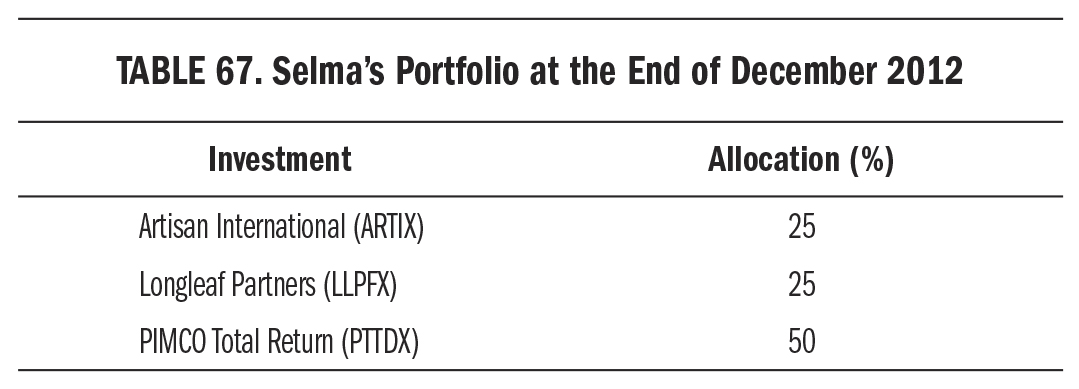
Visit (http://bit.ly/1upILVU) for a larger version of this table.
It was hard for Selma to miss that bonds had held their allocation in the supposed bull market under way in stocks. This, more than anything else, is why she continued resisting her financial planner’s advice to move more of her bond allocation into stocks. Why? For excitement? “No thanks,” Selma thought, and kept half her account in the only fund that had never let her down.
As for Mark, he just followed 3Sig with nary a thought about allocations or prognostications. It had issued two quarterly buy signals and two quarterly sell signals in 2012, and he followed each as always. In the current fourth quarter, it signaled a minor buy of $3,226 worth of IJR, fiscal cliff fracas notwithstanding. Even after the buy, his bond allocation was 16 percent of his account, well within the comfort zone. After the usual quarterly fifteen minutes of easy calculating and order placement, he rejoined his family for holiday activities.
June 2013
Halfway through their thirteenth calendar year at SnapSheet, the 401(k) balances of our three investors showed Mark miles ahead:
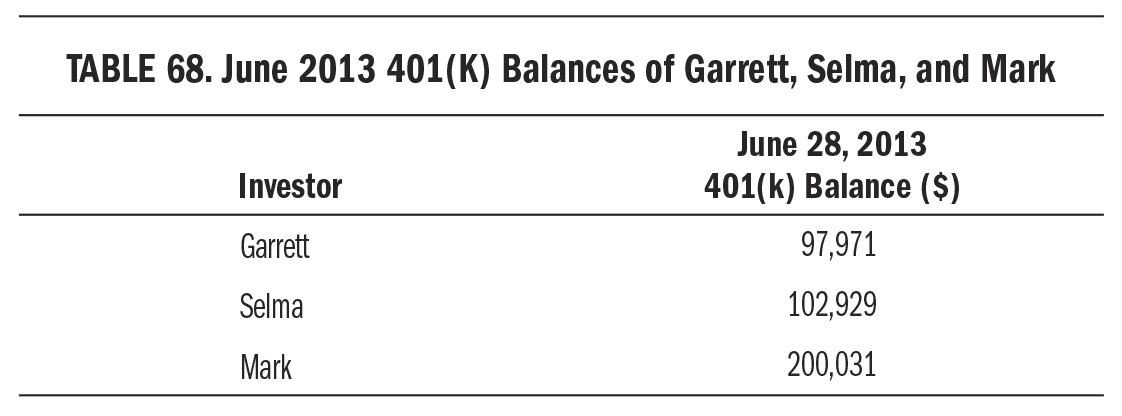
Visit (http://bit.ly/1y9evyR) for a larger version of this table.
Garrett was pleased to see his gut instinct about the price of gold pay off in spades. It slipped under $1,600 an ounce in February and kept falling to less than $1,250 that June. The shares of GLD he sold for $162 at the end of December fell to $119 six months later, a 27 percent drop that he avoided by paying closer attention to the market than did most investors—at least that was his explanation. His replacement for GLD, Fidelity Advisor Small Cap, was up 16 percent in the same six months, making him feel doubly clever to have made the switch.
His DoubleLine Total Return ran circles around Selma’s PIMCO Total Return, too. DoubleLine slipped 2.7 percent in price while paying a total of 25.2 cents in monthly dividends. PIMCO slipped 4.3 percent in price while paying 13.0 cents in dividends. Garrett still had the better bond fund! Too bad his small-cap stock fund wasn’t doing any better than Mark’s plain old IJR index. Fidelity had gained 16 percent in the first half of the year, but so had IJR. Worse, Fidelity paid nothing in dividends, while IJR paid out 49.6 cents per share. He decided to stick with Fidelity anyway. Maybe Small Cap’s carefully chosen stocks that analysts marveled about the previous December would start to pull ahead of the index.
In any event, Garrett felt good to have gained 12 percent overall in the first half, including his contributions. That blew away Selma’s 6 percent and wasn’t too far behind Mark’s 15 percent.
Selma had established deep enough trust in PIMCO Total Return to overlook its recent rough months, partly because it was easy to see the thorny patch it faced in the bond landscape. The New York Times DealBook reported on June 24, 2013, that retail investors had sold “a record $48 billion worth of bond mutual funds so far in June” and that hedge funds and other big institutional investors had also been “closing out positions or stepping back from the bond market.” Hans Humes, chief executive of the hedge fund Greylock Capital, told the paper, “The feeling you are getting out there is that people are selling first and asking questions later.”
From the end of April to the end of June, Bill Gross’s fund lost 5.1 percent, plus it paid dividends of only 2.2 cents and 1.7 cents, respectively, in May and June. The media pounced on Gross, saying he’d left his fund overexposed to rising yields when Federal Reserve chairman Ben Bernanke told Congress on May 22 that the central bank might begin tapering its stimulative bond-buying later in the year.
Gross defended himself in the June 25, 2013, online edition of Barron’s: “High levels of leverage, both here and abroad, have made the global economy far more sensitive to interest rates. Whereas a decade or two ago the Fed could raise the fed funds rate by 500 basis points and expect the economy to slow, today if the Fed were to hike rates or taper suddenly, the economy couldn’t handle it. All this suggests that investors who are selling Treasuries in anticipation that the Fed will ease out of the market might be disappointed.”
Bloomberg reported two days later that bond funds had experienced record monthly redemptions through June 24 “amid signs the country’s central bank may scale back its unprecedented stimulus.” It warned that rising rates could “trigger hundreds of billions of dollars in redemptions” from bond holdings. Investors had already plucked $1.3 billion from Gross’s fund in May, which was down 4 percent for the year, “trailing 93 percent of rivals.”
“Let them go,” Selma thought. Anybody viewing these modest setbacks as cause for concern obviously hadn’t lived through the kinds of stock crashes she’d seen over the years. She would keep her capital in PIMCO, because if there was anybody who would find the way forward, it was Bill Gross. She left her account exactly as it had been, confident that the almost imperceptibly listing ship of bonds would right itself.
Meanwhile, unaware of all market drama, Mark ran his quarterly calculation at home. The plan signaled its second sale in a row for the year, but a small one, at just $202. The first-quarter sale had been $11,470. That pushed his bond allocation up to 24 percent, where it remained after the second-quarter sale. It looked like another bull market was under way in his IJR ledger, and he would probably have to rebalance his bond allocation back to 20 percent after it reached 30 percent again, just as he’d done in the dot-com crash recovery eleven years earlier. “The more things change, the more they stay the same,” he thought. He closed his notebook for the quarter and went for a walk.
Analysis
Which of these three investment paths would you like to follow? More people than you think choose Garrett’s path, flitting from one investment idea to another based on the news of the moment or the expert du jour, most of which fade out with time. If anything, this history was too kind to Garrett, limiting him to a focused portfolio of mostly reasonable ideas. In the real world, investors such as Garrett end up with dozens of positions in their portfolios, some that are downright loony, and their performance suffers accordingly.
All things considered, Garrett didn’t do too badly. His Air Transportation fund performed well in the first quarter of 2002. Keeping his monthly contributions in safe cash for six months from that year’s difficult autumn worked out as he’d hoped, and he was able to buy cheaper prices later. His Fidelity Select Defense & Aerospace Portfolio fund was a winner during the early years of the Iraq War. His ExxonMobil position held up in the volatility of the subprime mortgage crash of 2008 and paid a reassuring dividend that even grew through the mess. He made an excellent choice in buying DoubleLine Total Return. He bailed out of gold before its 2013 swan dive.
Getting some moves right is trickier than getting none right, because it feeds false hope. Among Garrett’s mistakes were just enough good calls to keep the illusion of market-beating skill alive in him. This is often the case, and it’s bolstered when the market hits a bull stride. Garrett became extra confident in his skills, mistaking his growing account balance at the peak of the bull for talent rather than luck, and dispensing officious analytical advice with all the authority of a real z-val. I’m not ridiculing Garrett here, because he’s not unique. He’s an archetype, cloned countless times and set loose with real money in the market’s house of mirrors. While he serves as a cautionary tale, let’s at least give him credit for getting several things right in his journey through the zero-validity environment.
He fared worse than Selma, however, even though she expended much less energy in the management of her account. Her well-researched portfolio of superb funds combined with relentless dollar-cost averaging into them powered her higher through good times and bad. Well, not all the bad times. Her decision to retreat to PIMCO Total Return in the depths of the autumn 2008 credit crisis was the exception, but a better call than hiding in cash, as Garrett and millions of other investors did at that time.
Of course, the best performance by far was Mark’s, and he achieved it with little stress and low expenses. He followed 3Sig to remain mostly calm through this tumultuous time in financial history. We have to say “mostly calm,” because even the stoniest investors were unable to ignore the calamity of the credit crunch. People following the signal plan should do so in full awareness that it’s possible for a buy signal to demand more capital than is available in an investor’s bond balance, and it’s unnerving to put bottom-buying capital to work. It happens only in the worst of circumstances, when the news is at its most dire, the z-vals at their loudest, the throngs of Peter Perfects at their preachiest . . . and prices at their lowest. That’s why it’s called a bottom-buying account, after all.
This is hard to get through our heads. It’s the worst news that produces the best buying prices. Because we’re easily gripped by fear, which can prevent us from taking advantage of splendid buying opportunities, we need the signal to overcome our inclinations. It tells us what to do. Even when you can’t do exactly what it tells you, as happened to Mark in March 2009 at the very bottom of the bear, you can follow it in spirit to much better results than if you try interpreting the cacophony of information from supposed experts.
The coin tossing commentators bellow their most confusing harangues precisely when it’s important to do the right thing by either buying low or selling high. When prices are low, we’re fearful and more likely to tune into the doomsayers urging caution. When prices are high, we’re greedy and more likely to tune into the cheerleaders urging aggression. Even if only half the voices urge selling at the bottom and buying at the top, our tendencies put the odds on following the wrong ones. Because key moments to buy and sell with significant impact are rare, it doesn’t take many missed moves to impair performance permanently by either buying a major top or selling a major bottom. Just ask Garrett and Selma. Their missing most of the rally off the March 2009 low probably destroyed their chances of ever retiring with as much money as Mark will amass.
Stick with the dispassionate signal. It’s smarter than the z-vals and even smarter than a collection of top-ranked managers of the type Selma assembled. She did extremely well, considerably better than almost any average 401(k) account in this same time frame, because most portfolios end up in mediocre funds that overcharge and underdeliver. Whereas Selma sat atop a collection of blue-ribbon funds, most investors are lucky to average honorable-mention funds in their lousy lineup of choices. You can be sure that if plain old indexes in the signal plan beat a portfolio containing all-stars like Artisan International, Longleaf Partners, and PIMCO Total Return, they’ll stomp ordinary funds to bits.
The fact is stocks trade as a block in extreme times, which are the very best times to be buying low or selling high. Even highly rated funds just mimic indexes in such times, making it hard to understand why anybody pays their expensive fees. In the fourth quarter of 2008, the heart of the credit crunch, almost all stock funds delivered wretched returns, even the ones leading the ranking systems at Morningstar and Value Line. Selma discovered this firsthand.
You may wonder if there’s an unfair comparison taking place. You might consider it convenient in this history that both Garrett and Selma lost their nerve at the bottom of the bear market while Mark stuck it out. This isn’t unfair, though, because their choice to sell was common at the time, as you’ll read in a moment. Providing investors with clear signals to do the right thing, such as buying into bear markets and staying put through bottoms, is the very point of 3Sig and is necessary for the very reason that investors so often do exactly the wrong thing. Garrett bailed out because he listened to z-vals, and an enormous percentage of investors did as he did in the credit crunch.
In a December 22, 2008, story titled, “Stock Investors Lose Faith, Pull Out Record Amounts,” The Wall Street Journal reported that “a record $72 billion” fled stock funds in the previous October alone, according to the Investment Company Institute (ICI). Later, ICI would report that by the end of the year, stock funds had lost $234 billion. Nearly 42 percent of equity capital cashed out of cascading prices from May to December 2008, and investors panicked out of every fund category tracked by ICI: domestic equity, world equity, hybrid, total bond, taxable bond, and municipal bond in September, October, November, and December of that year.
The supposed smart money didn’t behave any more intelligently. In a December 14, 2008, story titled, “Fleeing Investors Put a Strain on Funds,” The New York Times reported that “a growing number of hedge funds are trying to slow the exodus” of investors racing for the exits. A representative of an investment advisory firm managing about $20 billion in assets said that withdrawals had been gathering steam for months as the markets collapsed. In January 2009, Hedge Fund Research confirmed this trend in reporting that $152 billion had fled hedge funds in the fourth quarter. The president of the research firm said in the statement, “Investor risk aversion remained at historically extreme levels through year end. Investor redemptions were widespread and indiscriminate across fund strategies, regions, asset sizes and performance.”
Garrett and Selma weren’t alone in bailing out of the market. It’s easy to see the pressure they faced to do so. In that very difficult moment, Mark’s 3 percent signal advised getting in with both feet, the very opposite of popular pressure. The signal was right.
A main takeaway from this history is that almost all market information is noise. Notice the recurring news themes in this chapter, some of which are undoubtedly reappearing in the financial media as you read these words. There’s always strife somewhere in the world, and somebody always worries that it will pressure stock prices lower. Federal Reserve policies are always offered as evidence that either higher or lower stock prices are on the way. Washington is always dysfunctional, forever pushing the country over some kind of cliff or past a point of no return, and somebody always expects this to either damage stocks immediately or mute their future performance.
Z-vals always keep at hand a list of beaten-down stocks recommended for dramatic recovery, some of which do recover while others don’t. They crow about the coin tosses they win and stay quiet about the ones they lose. Investors following such tips will also win some and lose some, then feel emboldened by their random winnings that don’t add up to as much as they would have made by just owning a stock index with most of their capital. Analysts never say they were wrong, just early or late. Finally, there’s always an obsession with “the current market” or “today’s market” or “the market now,” implying that there’s something unique about the breaking news of the moment that investors must consider.
Over time, almost none of these recurring themes matter, and without the benefit of hindsight, even the ones that do matter are indistinguishable from the ones that don’t. The best we can do is react intelligently to what already happened in the past rather than guessing what might happen in the future. The 3Sig plan is designed for this purpose.
Here’s a chart of our three investors’ 401(k) balances over the time frame in this chapter, December 2000 to June 2013, using the twelve balances shown in the narrative as data points:

The 401(k) balances of Garrett, Selma, and Mark, December 2000 to June 2013.
Notice that in the 2003–2007 bull market, both Garrett and Selma pulled close behind Mark. This is to be expected when an investor begins 3Sig at or near the beginning of a bull market, because they will not be fully invested in stocks during a phase of strong appreciation. As we saw with our three investors, 3Sig tends to reassert itself for a permanent or at least long-term lead over competing strategies when it signals buying into and holding through bear markets. Almost all other strategies fall apart in extreme bear markets, given their lack of guidance to the contrary of what media and our instincts tell us to do. Locking in bear market losses then missing out on subsequent bull market gains translates into permanently diminished end balances for most investors. Those, such as Mark, who stay with 3Sig will not suffer this fate.
Don’t think I forgot about the identical savings account set up by our three investors. Beginning in 2003, each contributed 4 percent of their gross salary. Only Mark used his for anything during the time frame, withdrawing $10,876 in the fourth quarter of 2008 to fund the first of two big buy signals during the bottoming of the credit crisis, and $2,984 in the second quarter of 2010 to fund the first buy signal coming out of his “30 down, stick around” phase. Garrett and Selma never withdrew any of their safe savings. Here’s how their savings accounts concluded the period:
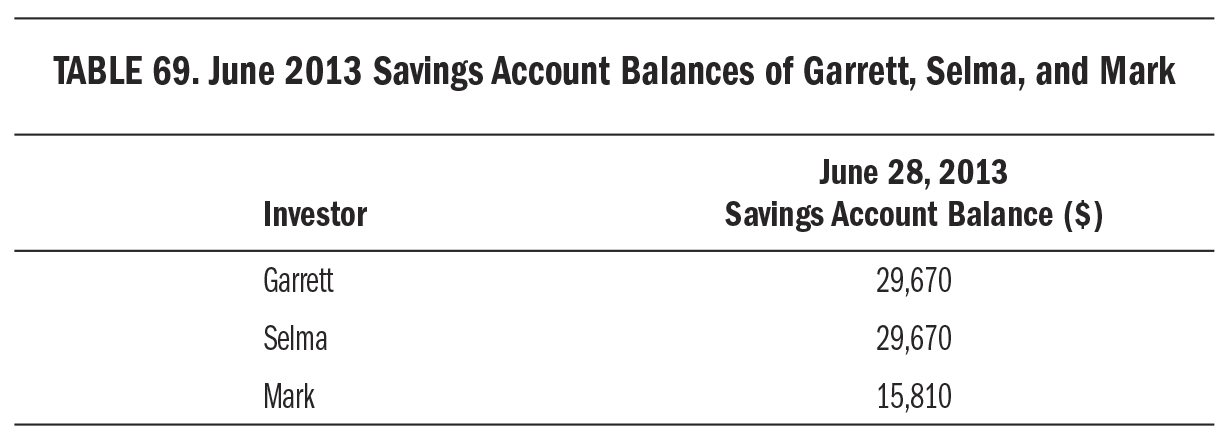
Visit (http://bit.ly/1t7NgsW) for a larger version of this table.
Using the savings account for bottom buying proved well worth it for Mark. Even after considering the $13,860 less he had in savings after funding the two buy signals, he still finished far ahead of his peers. This is for obvious reasons. Money invested at key stock market bottoms will always outperform money parked in static cash.
You may wonder how 3Sig stacks up against other variations that, however unlikely in the real world, are intriguing to consider. The next table starts off with the results of our three investors, then shows how ten other plans would have fared with their same monthly contributions:
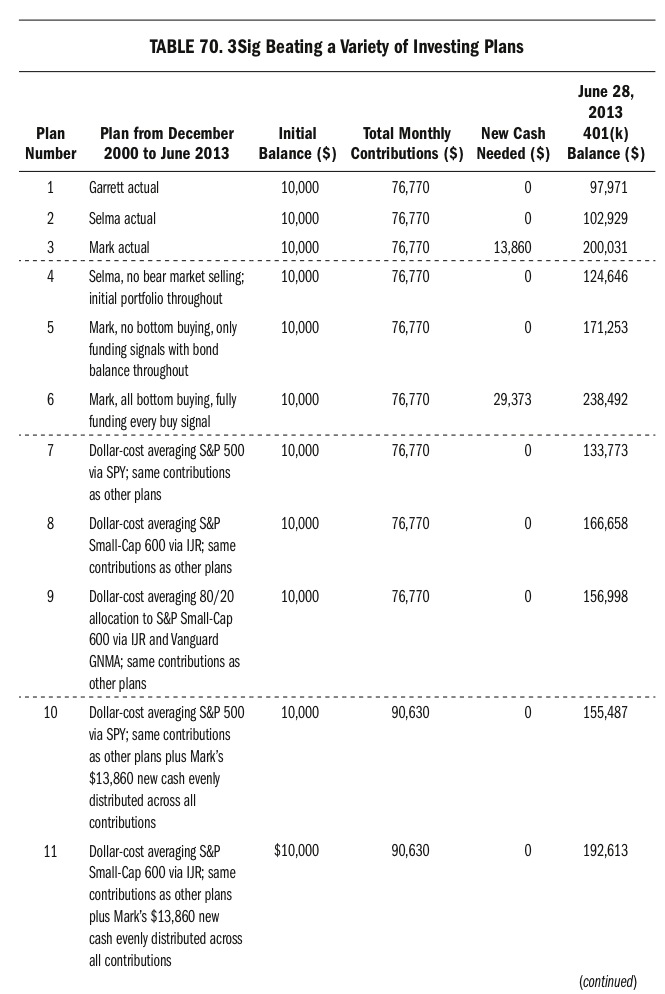
Visit (http://bit.ly/1AZPb0i) for a larger version of this table.
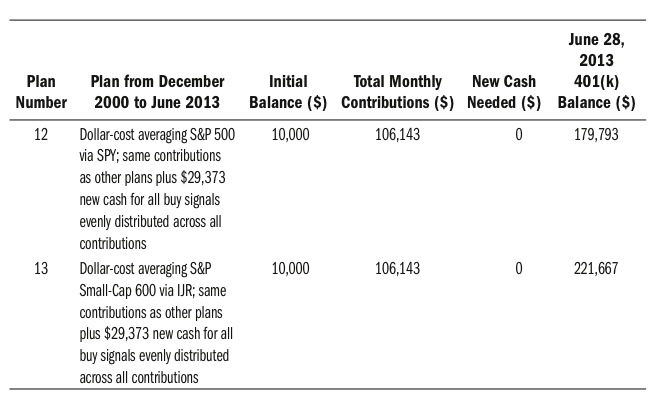
Visit (http://bit.ly/1CmBkoT) for a larger version of this table.
This table shows 3Sig outperforming other approaches even when they’re perfectly executed. Add in the near certainty that they won’t be perfectly executed, and 3Sig’s superiority becomes unmistakable.
Look at plans 4 and 5, which show Selma and Mark doing nothing but following their initial plans, no bear market selling for Selma or bottom buying for Mark. They ended up with starkly different balances: $124,646 for Selma and $171,253 for Mark. This is a resounding triumph for 3Sig because it vanquished Selma’s portfolio, which included some of the most highly rated actively managed funds in the world, and did so paying 82 percent less than she paid in expense ratios. Remember that it’s now possible to run 3Sig at an even cheaper cost than Mark did because new ETFs offer the same index exposure at lower fees than the very low ones he paid, thus the cost advantage is greater these days. Remember, too, that 3Sig achieves a bigger outperformance against more typical portfolios of mediocre funds from the fat part of the bell curve, and better still against laggards at the bad end of the curve. The overwhelming majority of actively managed funds are worse than the champions that powered Selma’s portfolio.
Next, turn your attention to Plans 7, 8, and 9, which show dollar-cost averaging the monthly contributions of our three investors into the S&P 500 via SPY, the S&P Small-Cap 600 via IJR, and an 80/20 allocation to IJR and Vanguard GNMA, respectively. These perfectly executed dollar-cost averaging plans beat Selma’s all-star portfolio in Plan 4, but did not beat Mark’s 3Sig in Plan 5. This is another impressive feather in 3Sig’s cap.
The advantage of Mark’s bottom-buying account becomes clear when looking at plans 10 through 13. On top of the same monthly contributions, evenly distributing the $13,860 Mark used from his bottom-buying account across all 150 months of the time frame into SPY and IJR produced lower ending balances of $155,487 in SPY and $192,613 in IJR than Mark’s $200,031. If we take it a step further and add to the monthly contributions the $29,373 of bottom-buying capital required to have fully funded all Mark’s buy signals, we end up with $179,793 in SPY and $221,667 in IJR, but $238,492 in Mark’s 3Sig plan—the all-bottom-buying version shown in Plan 6.
Across several variations, then, 3Sig outperformed dollar-cost averaging: with no bottom buying against top-ranked funds and indexes, with partial bottom buying against indexes, and with complete bottom buying against indexes. If 3Sig beats the very formidable dollar-cost averaging strategy this clearly, it’s easy to see why less effective ideas of the day from z-vals and Peter Perfect fall utterly flat against it.
Executive Summary of This Chapter
The 3Sig plan provides a low-stress beacon through the chaos of the stock market. This chapter followed the experiences of Garrett, Selma, and Mark, three investors working at the same company earning the same income. Garrett followed z-val advice in his 401(k). Selma assembled a portfolio of superb mutual funds and dollar-cost averaged into them. Mark ran 3Sig with IJR and Vanguard GNMA. Even though he funded only two bottom-buying opportunities, Mark came out far ahead of Garrett and Selma. This is typical, and why you should run 3Sig in your retirement account. Key takeaways:
 Beware high expense ratios. Garrett and Selma paid much more for the funds they chose, but underperformed Mark’s cheap index funds.
Beware high expense ratios. Garrett and Selma paid much more for the funds they chose, but underperformed Mark’s cheap index funds. Frenetic activity is a waste. Garrett’s method of trying this and then trying that only frustrated him. His occasional wins provided false confidence that harmed him later.
Frenetic activity is a waste. Garrett’s method of trying this and then trying that only frustrated him. His occasional wins provided false confidence that harmed him later. Severe bear markets can be emotionally hard on 3Sig followers, too. Using a bottom-buying account isn’t easy when everybody is swearing off stocks, but it’s worth it.
Severe bear markets can be emotionally hard on 3Sig followers, too. Using a bottom-buying account isn’t easy when everybody is swearing off stocks, but it’s worth it. Because key moments to buy and sell with significant impact are rare, it doesn’t take many missed moves to permanently impair performance by either buying a major top or selling a major bottom. After panicking out of stocks in the bear market and then missing most of the recovery, Garrett and Selma are unlikely ever to catch up with Mark’s balance.
Because key moments to buy and sell with significant impact are rare, it doesn’t take many missed moves to permanently impair performance by either buying a major top or selling a major bottom. After panicking out of stocks in the bear market and then missing most of the recovery, Garrett and Selma are unlikely ever to catch up with Mark’s balance. There are many recurring themes cited as reason to think stock prices will move up or down, among them: global strife, Federal Reserve policies, and dysfunction in Washington. Over time, almost none of these recurring themes matters, and without the benefit of hindsight, even the ones that do matter are indistinguishable from the ones that don’t.
There are many recurring themes cited as reason to think stock prices will move up or down, among them: global strife, Federal Reserve policies, and dysfunction in Washington. Over time, almost none of these recurring themes matters, and without the benefit of hindsight, even the ones that do matter are indistinguishable from the ones that don’t. The 3Sig plan is designed to react intelligently to what has already happened. It doesn’t consider what might happen, and neither should you.
The 3Sig plan is designed to react intelligently to what has already happened. It doesn’t consider what might happen, and neither should you. Because 3Sig even beats formidable dollar-cost averaging plans into all-star funds and indexes, z-vals and Peter Perfect are annihilated by it.
Because 3Sig even beats formidable dollar-cost averaging plans into all-star funds and indexes, z-vals and Peter Perfect are annihilated by it.